
READER’S DIGEST | SMALL AND PERFECTLY INFORMED | SEPTEMBER 2016 SEPTEMBER 2016
of
Converted Spaces PAGE 64
Owes Me A Living”
varied career PAGE 20 SEPTEMBER 2016 £3.79 readersdigest.co.uk A New Lease Of Life! The first in a three-part series on care in Britain PAGE 54 What Should We Eat Now? PAGE 38
Best
British:
“Nobody
Alan Titchmarsh on his

features
12 IT’S A MANN’S WORLD
Olly Mann makes some astonishing discoveries about Japanese culture
e ntertainment
20 ALAN TITCHMARSH INTERVIEW
The nation’s favourite gardener reveals how he copes with fame
28 “I R EMEM b ER”: ANTHEA TURNER
The presenter opens up about her childhood and the defining moments of her career Health
38 WHAT TO EAT NOW
The latest advice might hold some surprises for you
Inspire
54 MA k E yOURSEL f AT HOME
The first of a three-part series on care looks at the new trend for assisted living
64 b EST O f b RITISH : CONVERTED SPACES
Attractions that give new purpose to historic places

76 THE SOLO SHEPHERDESS
Jodi Fenwick is transforming the modern shepherding profession, one lamb at a time
travel & a dventure
84 VIRTUES Of THE Off SEASON
A mother and daughter uncover the joys of the Greek Islands—without the crowds
96 SAVE THE fOREST
This Austrian couple are fending off corruption to save Europe’s last great woodland
JAmes e ckersley c over Illustr At I on By lA ur A Bre I l I ng 09•2016 | 1
©
Contents SEPTEMBER 2016
p76

WE kNOW HOW DEEPLy the issue of care matters to our readers, since it’s a subject that affects a huge number of people —from those weighing up their circumstances to those trying hard to provide for others. So we’ve decided to tackle it properly in a new three-part series on the future of care in Britain, starting this month with a look at the welcome rise in assisted living. Find out more on p54.
Further inspiration can be found on p76 in the shape of Jodi Fenwick, a 27-year-old who’s giving a youthful sheen to the ancient tradition of shepherding. And it’s hard to think of more inspiring people than Christoph and Barbara Promberger, the Austrian couple who have raised over £40m to protect Europe’s last great wilderness from the loggers—read the whole story on p96.

Speaking of enterprising people, we chat to Alan Titchmarsh on p20 about his 37-year TV career and his latest novel—his tenth in just 18 years. Some people have all the energy, it seems… tom Browne
theeditor@readersdigest.co.uk
facebook.com/readersdigestuk
twitter.com/readersdigestuk
pinterest.com/rdigestuk
google.com/+readersDigestuk1
| 09•2016 2 IN e V er Y I ssue 6 over to you 8 s ee the World Differently e ntertainment 17 s eptember’s cultural highlights Health 46 Advice: s usannah Hickling 50 c olumn: Dr m ax Pemberton Inspire 74 If I r uled the World: steve Jones travel & a dventure 92 c olumn: c atherine c ole Money 106 c olumn: Andy Webb food & Drink 112 tasty recipes and ideas from rachel Walker Home & Garden 116 c olumn: lynda clark technology 118 o lly m ann’s gadgets f ashion & Beauty 122 g eorgina yates on how to look your best Books 124 s eptember Fiction: James Walton’s recommended reads 129 Books that c hanged my life: robert Bathurst f un & Games 130 you c ouldn’t m ake It u p 133 Word Power 136 Brain teasers 140 l augh! 143 Beat the c artoonist 144 60-s econd stand- u p: Iain stirling e DI tor’s letter
Reader’s Digest is published in 31 editions in 15 languages

EDITOR-IN-CHIEF Tom Browne
ASSISTANT EDITOR Fiona Hicks
DIGITAL EDITOR Mandi Goodier
ASSISTANT DIGITAL EDITOR Anna Walker
ART DIRECTOR Yvey Bailey
GRAPHIC DESIGNER Richard Cooke
ADVERTISING DIRECTOR Simon Fulton
simon.fulton@readersdigest.co.uk 0203 701 5936
ADVERTISING ACCOUNT DIRECTOR Mike Allen mike.allen@readersdigest.co.uk 0203 701 5935
CEO Gary Hopkins
CHIEF OPERATING OFFICER Julie Leach
PARTNERSHIPS MANAGER Maggie Champion
TRUSTED MEDIA BRANDS INC (USA)
President and Chief Executive Officer
Bonnie Kintzer
Vice President, Chief Operating Officer, International Brian Kennedy
Editor-in-Chief, International Magazines
Raimo Moysa
For all subscriber enquiries, please use the customer services number below
WE PAY...
£50 for the star letter and £30 for regular letters.
Email readersletters@readers digest.co.uk or go to readers digest.co.uk/contact-us
WE ALSO PAY...
£50 for the true stories, anecdotes, jokes in Laugh! and You Couldn’t Make It Up…, and contributions to end-ofarticle fillers and My Great Escape.
Email excerpts@readersdigest.co.uk or go to readersdigest.co.uk/contact-us
SORRY!
We cannot acknowledge or return unpublished items or unsolicited article-length manuscripts. Do not send SAEs. Article-length stories, poetry and cartoons are not requested.
CUSTOMER SERVICES
Contact Customer Services for renewals, gifts, address changes, payments, account information and all other enquiries. Call 0330 333 2220* or email customer_service@readersdigest.co.uk
TALKING MAGAZINES
Reader’s Digest is also available in audio and accessible etext editions from RNIB Newsagent, for blind and partially sighted readers. Call the RNIB Helpline on 0303 123 9999 or visit rnib.org.uk/newsagent
SUBSCRIPTIONS
Visit readersdigest.co.uk or write to: Reader’s Digest, PO Box 7853, Ringwood BH24 9FH. UK: £45.48 a year. Republic of Ireland: €61.20 a year. Prices include delivery. For gift subscriptions, contact Customer Services.
4 | 09•2016 *Calls to 03 numbers cost no more than a national rate call to an 01 or 02 number and will be free if you have inclusive minutes from any type of line including mobile, BT or other fixed line PAPER FROM SUSTAINABLE FORESTS. PLEASE RECYCLE © 2016 Vivat Direct Ltd (t/a Reader’s Digest). British Reader’s Digest is published by Vivat Direct Ltd, 57 Margaret Street, London W1W 8SJ. All rights reserved throughout the world. Reproduction in any manner, in whole or part, in English or other languages, is prohibited. Reader’s Digest is a trademark owned and under license from Trusted Media Brands, Inc, and is registered with the United States Patent and Trademark Office. All rights reserved. Printed by Pindar Scarborough Limited. Newstrade distribution by Seymour Distribution Limited. WRITE TO US! SEND US YOUR STORIES, JOKES AND LETTERS OR VISIT OUR WEBSITE SMALL PRINT: Ensure submissions are not previously published. Include your name, email, address and daytime phone number with all correspondence. We may edit letters and use them in all print and electronic media. Contributions used become world copyright of Vivat Direct Ltd (t/a Reader’s Digest).

In Memoriam: Elizabeth Adlam
Everyone at Reader’s Digest was saddened to hear about the death of Elizabeth Adlam, one of our most respected and long-standing writers. Elizabeth was associated with our magazine for over 40 years, researching and writing articles —mostly on health matters—for both the UK and Australian editions. She was a life member of the Guild of Health Writers and also a member of the Medical Journalists’ Association. She won awards for her writing and research from both organisations, but the one that gave her the most pride was from the Guild of Health Writers for an article published in Reader’s Digest entitled “The Picture That Saved A Baby’s Life”, dealing with a case of retinoblastoma.
Elizabeth was working on assignments for Reader’s Digest until just before her death. She will be very sadly missed.








5 09•2016 |
google.com/+ReadersDigestUK1
twitter.com/readersdigestuk facebook.com/readersdigestuk pinterest.com/rdigestuk
NO PLACE LIKE HOME readersdigest.co.uk FOR MORE, GO TO READERSDIGEST.CO.UK
For the full gallery, and to discover where these photographs were taken, visit readers digest.co.uk/travel
These places of outstanding natural beauty are so stunning that you won’t believe they’re in Britain.
Over to You
lette R s on the JU lY I ss U e
We pay £50 for Letter of the Month and £30 for all others
✯ letter of the month...
I loved the section in Michael Foley’s “If I Ruled the World” about how we should all play more. I work in a primary school and I recently came across a poster stating that when kids play, they’re actually working because they’re learning through play. I think much older “children” could learn from this too. Adults often get tunnel vision and lose their ability to rectify problems easily, becoming locked in a cycle of stress, anger and demotivation.

If a small dose of me-time in a paperwork-free zone were introduced daily to the working environment, creativity and reflection would be encouraged. As a result, many of the problems we encounter during the working day might be solved more quickly and effectively.
SUE WATT, Fife h APPY CA m P er
Thank you for your feature “Best of British: Campsites”. The great thing about caravanning is that you can go to places and if you don’t like them, you just hook up and go somewhere else. If you book a holiday and you don’t like it, you’re stuck!
The places you stay while camping
are a lot cheaper as well. Being out in the countryside, getting fresh air and going for walks with your children, who can play all day...there are many benefits.
I’ve made a note of your campingsite suggestions. They definitely look worth a visit!
PAUL MADDOCKS, Hertfordshire
Photo/Illustrat I on cred I t 6 | 09•2016
A fAI thf U l non-B el I e V er
Your feature “Live Better, Help Often, Wonder More” struck a chord with me. I go to church but I’m an atheist. People wonder why I go, but I like to support my local church and enjoy singing. I value the services in an odd way, which has little or nothing to do with belief and which, in fact, always seems to involve a reassertion of unbelief.
Sanderson Jones’s type of church service for the godless therefore definitely appeals to me. I think they might just catch on.
SHULAH CLARKSON, Norfolk
A m A n of m A n Y tA le nts
The interview with Danish actor Mads Mikkelsen (“A Journey to the Dark Side”) resonated with me. My husband is a struggling playwright and dreams of the day when one of his plays makes it to the West End or gets turned into a film. Mads is in favour of low-budget and blockbuster projects, and I think it’s great he gives writers like my husband a chance to show what they’re worth.
I hadn’t realised Mikkelsen trained as a gymnast in his youth and studied dancing at a ballet academy. He has many strings to his bow.
KYM YESSEN,
Cambridgeshire
fern A n D fAthers
I enjoyed learning more about Fern Britton in “I Remember”. I’ve always enjoyed watching her on television; she comes across as a really nice person.
She remembered that she hardly saw anything of her father growing up. I think, years ago, this was quite common. I don’t remember seeing much of my own father, and at times he even seemed like a stranger. He worked long hours and I must have only spent ten minutes before bedtime conversing with him a couple of times a week. I’ve made sure not to make the same mistake with my own children.
COLIN MCCAULEY, London
heels A n D memor I es
Melanie Lodge’s childhood memories of Blackpool in “Over to You” made me chuckle, as it reminded me of an event from my youth. While walking down Southport Pier, I saw a very well-dressed young lady get her stiletto heel caught in the slats. She was really panicking until my dad asked her to step out of her shoe; he managed to free the offending article and she gingerly carried on down the pier. I bet she got the train back up!
BARBARA CANSELL, Wigan
7 09•2016 |
WE WANT TO HEAR FROM YOU! Send letters to readersletters@readersdigest.co.uk Please include your full name, address, email and daytime phone number. We may edit letters and use them in all print and electronic media.


the page 9
SEE THE WORLD Turn

Students of the Shaolin Tagou Martial Arts School exhibit complete body control and nerves of steel while performing for the opening ceremony of the 2014 Youth Olympic Games in Nanjing, China. True to the motto “Build a Dream”, 120 acrobats erected a 138-foot-high human tower, whirling through the air on 260 ropes. The previous photo shows the young athletes during training.
10
...DIFFERENTLY

Sushi-loving Olly Mann finds himself at a “Hyper Japan” event—and is astonished by what he discovers
A Curious Case Of Cat Ears

Olly Mann is a writer, LBC presenter and serial podcaster, with shows including Answer Me This!, The Media Podcast and The Modern Mann
i came late to japanese food. The home counties of the 1980s provided, you see, just two categories of “family” restaurants: Italian for the conservative heartland, or TexMex for the yuppies. As a child I adored both, for their lurid servings of cheesy, salty meatiness: pizza and pasta, quarterpounders and loaded potato skins. Yum.
The opportunity to expand my palate would arise only if a classmate’s parents stumped up for a birthday meal in the West End: a trip to Chinatown for my bezzie’s ninth birthday (followed by a performance of Cats) introduced me to chicken and sweetcorn soup. Another friend, turning 14, facilitated the debut of lamb jalfrezi on my culinary jukebox. Then, as a student, I discovered kebabs. (Not women, sadly. Kebabs.) But Japanese food? I didn’t try that until I was about 26.
i mention this because japanese food has, of late, become My Thing. I sip rice tea when I’m working, between cups of coffee. I schedule meetings at Itsu instead of Pret. When tackling a hotel buffet, I head first for the Japanese breakfast: I once wolfed down two cold helpings of a delicate curdled egg concoction while on a stag do in Mexico, as my fellow bachelors swigged on breakfast Buck’s Fizz. I’ve learned to love the lightly fishy, lightly spicy exotica of Japanese food. And I want to eat as much as I can.
But here’s the thing. Though I now love the cuisine, I can’t
| 09•2016 12
It’ S a Mann’ S World

get my head around the culture. I mean, I’ve played a lot of Super Mario in my life, and my in-laws bought me a kimono for Christmas, but there’s a lot of Japanese stuff— anime, karaoke, karate, the whole
dressing up as a schoolgirl thing —which strikes me as alien and mystifying. But could it be I’m missing out? Could more exposure to wide-eyed plushie dolls turn me into a fully-fledged Japan Fan?
Reade R ’s d igest 09•2016 | 13 Illu S trat I on by CH arlott E Far ME r
It was this train of thought that lead me to Britain’s biggest festival of “J-Culture”, Hyper Japan at London’s Olympia. I visited with my friend Nate, who has almost opposite interests, Japan-wise: he became fascinated by their tech, fashion and trends after visiting the country on a business trip, but has no particular appetite for their food. (There was a great selection of street grub at the exhibit, as you might imagine. I had mango bubble tea and a tray of takoyaki—fried wheat balls filled with minced octopus. Nate opted for beer, chicken and chips.)
but nate is a journalist, and tends to explain his interests in an impartial and comprehensible fashion, so I thought he’d be a reliable guide. This time, however, he showed up wearing cat ears. It turns out “cosplay”, the trend for dressing up as your favourite animated character, is adopted by around 30 per cent of the crowd. Nate only had the headgear, but one poor soul was fully turned out as Sonic the Hedgehog—a brave decision in a sweaty exhibition hall on one of the hottest days of the year. Others came dressed as sword-hurling
Manga heroes, or pink princesses— including a plump man in his 60s, who seemed to have shaved his legs for the occasion.
“The cat ears thing is a genre within a genre,” Nate said, unconvincingly.
“Is it a sex thing?” I asked.
“It’s kind of a sex thing,” he acknowledged. “Everything here is kind of a sex thing.”
Cos-play, the trend for dressing up as your favourite animated character, is adopted by 30 per cent of the crowd
We stumbled across a stall selling “love pillows”—four-foot long cushions emblazoned with images of cartoon characters. “Some men in Japan have been reported to marry these pillows”, Nate explained. “They hug them. It’s like a comfort blanket that got out of hand.”
He gestured at a pillow featuring a cartoon teenager. As far as I could tell, this pillow was surely under the age of consent. She had cutesy blush cheeks and rosy red lips, and was crouching suggestively, in stockings and a very tight PVC bra, with huge boobs and, most bizarrely of all, bunny ears. (Not in the style of Playboy bunny ears, but actual rabbit ears protruding from her skull, instead of human-girl ears.) All in all, I suspect, a fairly niche fantasy.
Yet here were thousands of attendees who didn’t bat an eyelid
It’ S a Mann’ S World | 09•2016 14
at this product—or the necklace pendants in the shape of mutant cat burgers, or the baby-panda pencil cases carrying the slogan “CUTE BAG”. To them, this all seemed just as mainstream as the Nintendo stand, or the YO! Sushi in the food court. After a few hours in their company, I even found myself becoming deadened to
my initial reaction (“What the hell is that?!”) and stopped sneering at the neon signs for the shops, with names such as Jazzy Menagerie and Cakes With Faces. I began, almost, to feel part of the club.
Then an opportunity arose for me to buy my very own cat ears, for £20. No, I thought, I’ll stick to the sushi.
budding authors, take a bow!
This arresting, emotive tale was one of thousands submitted to this year’s 100-Word-Story Competition. We’re publishing a commended story every month.
borderLine
the dirty rain soaks the tattered shirt clinging to my back. I’m cold standing in this queue, the road beneath me little more than a muddy track from all of the feet that have pounded there. the line shuffles forward and I’m faceto-face with the border official. He says something to me, but I can’t speak much English.
“alone, just you?” he says.
His eyes ask me why—where’s my wife, my son? “yes.”
I can’t tell him, I don’t have the words. I hope he can see in my face that there wasn’t anything left to bury.
Matthew Ward, Dorset

Matthew says: “My story is about the refugees migrating to Europe. The concept was that all of these people have such humbling—and often very tragic—stories that are overlooked when they’re only thought of as ‘the refugee crisis’ and not as individual people. I’ve always been more of a writer of long fiction, so writing an 100-word story was an interesting new challenge, but I had a lot of fun trying it out!”
Matthew will receive a cheque for £50
Reade R ’s d igest
09•2016 | 15




AYorkshireman’s
he only ever aspired to be a gardener, so how did the lad from ilkley become both tV royalty and a best-selling author?
By FIONA HICKS
Since he began working aged 15, Alan Titchmarsh has—in no particular order—presented the Chelsea Flower Show for three decades, hosted his own chat show for eight years, headlined the most popular gardening show ever, presented a radio slot that routinely draws in millions of listeners, written nine best-selling novels and churned out countless gardening books and columns. Oh, and he’s also made over Nelson Mandela’s garden.
e N tertAIN me N t 20
photo: © Vibrant p ictures/ a lamy s tock p hoto
Tale
 Alan at the Chelsea Flower Show this year
Alan at the Chelsea Flower Show this year
It’s a staggering list of achievements for anyone—let alone a man who doesn’t consider himself ambitious.
“When I was watering plants in the Parks department, did I ever think, Wouldn’t it be nice to present the Last Night of the Proms on the BBC?” he chuckles. “It was so far beyond my compass, it would have been an absurd dream to imagine.”
Indeed, this Yorkshireman’s story certainly didn’t begin with TV prime-time slots and nationaltreasure status. Born to a plumber father and a textile-millworker mother, he left school before his 16th birthday to work as an apprentice gardener with Ilkley Council.
“At that stage, I was just happy to be growing things and working with plants,” he says. “My boss in the Parks department said I should do my apprenticeship there, then go to college for a year, then go to Kew or Edinburgh or Wisley for three years for a diploma. Then I was to go to something called the Institute of Park and Recreation Administration for a year, eventually to become a park superintendent. That prospect didn’t particularly excite me.”
journalism, raising his profile as a gardening expert—which led to his first TV gig in 1979.
“My life has been a series of observed opportunities and calculated risks. That’s the only way I can look at it,” he muses. “It’s being observant enough to spot things that come out of left field. And foolhardy enough to have a go.”
If I’d set out when I was younger to be a TV presenter, how the dickens would I have managed it?
This foolhardiness has certainly paid dividends. Since 1980, Alan has been on British TV every single year (“and most weeks too,” he adds), appearing on Pebble Mill, Gardeners’ World, Ground Force and even The Alan Titchmarsh Show, among myriad others. It’s a career of which many can only dream—a fact that hasn’t passed Alan by.
“If I’d set out when I was younger to be an actor or a chat-show host or a TV presenter, how the dickens would I have found my way into it? It would have been impossible. So I came in via the back door as a gardener. I’m enormously grateful for any and every opportunity I’ve had.”
He pauses. “It probably sounds very twee to say things like that, but I’m a realist—nobody owes me a living.”
Alan got as far as Kew in this career plan and realised he needed more stimulation. He therefore moved into
If not ambition, then, what exactly has driven him to such an eminent (and lucrative) position?
22
| 09•2016 © peter jordan/ a lamy s tock p hoto a yorkshireman ’ s tale

“I’m quite good at getting along with folk,” he says simply. “We all encounter people who are a bit odd, but generally speaking the human race isn’t a bad lot. I enjoy conversation and I’m genuinely interested in people.
“I’ve never been driven by money —it’s been very nice when it’s been there, I’m not knocking that—but I’m driven by stimulation.”
a lan, for all hi S mild manner S, is quite a divisive figure. Some find his particular brand of pleasantry
charming, while others don’t quite buy into it.
“Some people don’t take what they see as being what is. They think it’s a front,” he sighs. “When people don’t allow for the fact that you’re allowed to be like you and they’re allowed to be like them—a strange sort of prejudiced intolerance—that’s dispiriting. You just think, Why am I bothering?”
Although he’d already been on TV for 17 years by 1997, when Ground Force aired to 12 million viewers, he got a bit of a shock. “Suddenly
23
09•2016 |
Alan in 1985. He’s been on TV “most weeks” since then
everybody in the street knew who I was. I remember coming home and thinking, I’m not sure if I like this. But I had two choices: either get used to it and knuckle down, or get out now. I loved doing the job, so I got used to coping with it. I’m not one of those people who’ll go to the opening of an envelope for the sake of it. Fame is a by-product of what I do—not a goal in itself.”
He concedes that he’s fundamentally a “sensitive” soul, but he’s learned to maintain perspective. “I don’t take myself too seriously. I remember Margot Fonteyn’s dictum, which I’ve stuck to most of my life: to take your job seriously is imperative, to take yourself seriously is a disaster. It’s a good rule to remember. Everybody’s special, but you’re not that special. I look at the behaviour of other people in the business—no names mentioned—and think, Oh, come on, you want a good smack. Stop it.”
On the flipside, of course, are the people who adore Alan and his warm familiarity. In fact, there’s a rumour that his figure in Madame Tussauds has to be cleaned twice a week to wipe away all the lipstick marks. “It makes me smile and makes my wife raise her eyebrows,” he laughs. “It’s very flattering, but you can’t take it too seriously.”
Suddenly everybody in the street knew who I was. I loved the job, so I got used to coping with it
d e S pite being a Stalwart of the industry, the 67-yearold finds that TV today is a very different beast to when he started. “It’s harder to find things now that you really want to do. These days when I’m offered something, I find myself thinking, Do I have more to lose or to gain from this? I’m careful about what I pick. I’d never in a million years do something like I’m A Celebrity…Get Me Out of Here! or Big Brother. I’d lose credibility and it’s just not my bag.
He cites his Northern upbringing and the old adage “If you can’t say anything nice about somebody, don’t say anything at all” as informing his own attitude to others. “But life isn’t like that. People like to have a pop. So you grit your teeth and hope that tomorrow it’s fish-and-chip paper.”
“That said,” he continues, “it’s very nice to be asked to do Strictly Come Dancing—and I’ve been asked several times—but I’ve so far declined. Mainly because my wife says my knees wouldn’t take the lifting.”
Whether or not he dons dancing shoes, he’s certainly being kept busy with his writing. He says it
24 | 09•2016
a yorkshireman ’ s tale

was another bout of “foolishness” that made him pen his first novel in 1998—and he’s just completed his tenth, which (like the others) is set to be a best-seller. The writer’s life is certainly very different to that of a television star, but it suits Alan rather well. “The great thing about being a writer is that you can do it quietly at home with bits falling off of you, and people can’t see how dreadful you are to look at. Whether or not you can do that in TV, I don’t know.”
His latest book, Mr Gandy’s Grand Tour, is a typically Titchmarsh-esque tale. Alan’s voice shines through in the homely eponymous character, a widower who uses his new-found freedom to travel across Europe.
“The lead character tends to have a lot of my sensibilities,” he admits.
“You’re exploring possibilities that might have happened to people in the same situation.” Considering that before his wife’s untimely death, Mr Gandy was rather unhappily married, Alan found he had a bit of explaining to do on this last point. “My wife, bless her heart, said, ‘It’s not about us, is it?’ I said, ‘No, no, no!’ ”
In fact, Alan and his wife Alison celebrated their 41st wedding anniversary in July—and happily so. “How did we get this far?” he jokes. “Keeping talking. Sharing. Communicating. We always had supper together when the children were young, and Ali and I do still— though now it’s often on the lap in front of Midsummer Murders.
“The bottom line is respect and enormous fondness for one another.
25 09•2016 |
© tony sapiano / re X/ s hutterstock
The ground force team—Charlie Dimmock, Alan and Tommy Walsh —pictured in 2000
Alan teaching younger generations about gardening at the Grow For It event last year

It’s his wife and his family life (he has two daughters and now four grandchildren) that have helped to keep him grounded over the years. “I don’t like being away for more than a couple of nights. I’m not going to shuffle off this mortal coil saying, ‘I wish I’d made another programme.’ I’m going to shuffle off saying, ‘Oh, I wish I had more time with the kids, or friends, or my garden.’”
He does have more books and more TV programmes in the pipeline, but the gardening that so enthralled his 15-year-old self has been his most enduring passion. In fact, it’s affected his entire outlook on life.
“They say the difference between farmers and gardeners is that gardeners always think next year will be better, and farmers always know it will be worse,” he laughs. “I think as a gardener you are an optimist. You’re always planting to the future, always looking ahead.”
Perhaps that’s the secret to Alan’s success, after all. That can override passion—I’m not saying the passion isn’t still there— but if you rate your other half and get on with them, that counts for a lot.”
The Guinness Book of Records no longer supports sleep-deprivation attempts, due to possible health risks. however, the unofficial record is believed to have been set by cornish man tony Wright. in 2007, he stayed awake for 266 hours —largely, he claimed, to promote his self-published book Left In The Dark
SOurCe: WIKIpedIA.Org
© p aul d oyle/ a lamy s tock p hoto a yorkshireman ’ s tale | 09•2016
Alan’s new book Mr Gandy’s Grand Tour (Hodder & Stoughton, £18.99) is out now.
eep IN g y O ur eye S O pe N
K
26

Anthea Turner, 56, is a TV presenter. in her 30-year career she’s appeared on numerous programmes, including Blue Peter, GMTV and Top of the Pops.
Anthea Turner
“I Remember”
…being in a caravan in rhyl. It was on a beach and was owned by our next-door neighbours, so we got to stay in it. I remember having ice cream and mum and dad being there, as I was an only child—my sisters hadn’t arrived yet and I was two-and-a-half years old.
…our bungalow. It had probably been built around the 1920s by my grandfather. It was a beautiful house. My mum was born in that house, we were born in that house—everybody was born in that house!
My sisters Ruth and Wendy and I all have our birthdays between
May 25 and June 6, so we’d always have our birthday parties together in the summer. I remember lots of little girls running round at the parties— it was very much a family house. We had extensive gardens too and I could probably climb every tree in them. The whole family is very into their gardens.
…my parents working. My mum Jean was a teacher at a secondary school and my father Brian worked for the family business, which was the cabinet makers Turner & Sons. It was

28 ©
sT
P H o T o entertainment
Terry Harris/ a lamy
ock
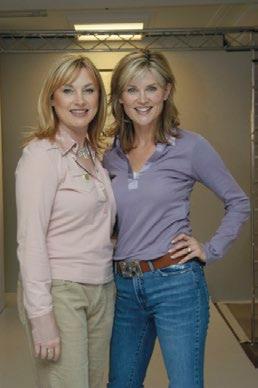

 (Above) Anthea with her sister Wendy; enjoying a family holiday with her mum and her younger sister Ruth
(Above) Anthea with her sister Wendy; enjoying a family holiday with her mum and her younger sister Ruth

princess, as there were always other things to deal with.
…having ponies. We used to get on them and go off for what felt like miles. In those days you didn’t have a mobile phone with you and Mum just said, “Be back for your tea.”
…my junior school. It was a five-minute walk down the road. There was a group of teachers there who particularly enjoyed putting on concerts and plays, so a lot of drama seemed to go on at school. In those days teachers had more of a free rein to teach how they wanted to teach. I don’t think there was much formfilling to do.
set up by my great-grandfather and they used to do a lot of work attached to pottery, as we come from Stokeon-Trent. They’d make display work for Wedgwood and Royal Doulton. It was an industrial time for the UK that unfortunately isn’t there any more.
…my northern-midlands upbringing. It’s an environment where you just get on with stuff, where “that’s the way it is and you better just deal with it”.
It’s a good thing. My sister Ruth was particularly handicapped so nobody ever had the time to be a
…i leaned towards making anything, painting anything— through to music, drama and dance. That was definitely my preference, probably because I’m dyslexic. A lot of dyslexics are always looking to do things where you don’t have to write stuff down.
…going to a girls’ grammar school. The headmistress there, Mary Edwards, was quite forwardthinking and inspirational. I’d had a tough time before arriving at that school because I’d been to a large comprehensive where they didn’t deal with anybody who wasn’t on track. This was the 1970s, when you
30 | 09•2016
© a lls T ar Pic T ure l ibrary/ a lamy sT ock P H o T o
Sporting a beret for “Le Walk” through the Channel Tunnel in 1994
My headmistress sent me to an educational psychologist, and they discovered this amazing word: dyslexia
were written off as remedial if you had any problems.
Some very good friends of my parents suggested I see Mary Edwards. Of my writing, she said, “Whatever it is, this doesn’t transfer into her vocabulary and she clearly knows all the answers. There’s obviously a problem with her written work and we need to find out what it is.” She took me on at this grammar school and sent me to an educational psychologist, and they discovered this amazing word that nobody can spell: dyslexia. From then on we were able to deal with it.
…i danced classical ballet. I started when I was about six—as far as I was concerned, it was my thing. My most enduring memory is aching feet, and dipping toes into surgical spirit to harden them up when I was 12 or 13. If I smell surgical spirit now, I always think of ballet.
…working for the automobile a ssociation. As much as I loved it, I wasn’t sure about ballet as a career, and when I was nearly 20 I just needed some money. The Automobile Association was shift work, which suited me, and while I was there they asked me if I wanted to do some broadcasting on the road-traffic reports. I did that and then some traffic reports for the local BBC station—and quite liked it!
…getting a job at a commercial radio station. I ran the record library at Signal Radio. I liked the business of radio and TV more so than the actual on-air stuff, though I did some of that too. I fibbed
Anthea rides in style with her father Brian

31 09•2016 |
r eader’s d igest

a lot—as I wasn’t quite sure I could do the job—but I really loved it.
…leaving to go and work for a record label in london. My boyfriend at the time had got a job working at Radio One and I was going to work for Magnet Records (part of WEA Records), but then I met somebody at a party who said, “Oh, they’re looking for a girl to do some video jockeying on Sky.”
Sky was in its infancy at the time and I did the audition on a bit of a whim. I linked a few videos together and chatted about music—and I got
Anthea presented Blue Peter from 1992 to 1994. “Those were the glory days of children’s TV”
the job. It was the era of Gary Davies and Pat Sharp. I never really looked back from there. I was 26.
…being at Blue Peter at a very exciting time. They’d celebrated 30 years so it was one of their landmark birthdays. At the time, we’d end up with 6.5 million people watching—far more than watch now. Those were the glory days of children’s TV.
32 | 09•2016
© Da V i D Gee/ a lamy sT ock P H o T o
I’ve been in this business since I was 26 and fame is a by-product of the job. You sort of get caught up in this strange life
..t OP OF t H e POPS was good fun. It was an iconic TV programme and it’s great to have done something like that. It was the New Romantic era. Meeting my heroes went with the territory, but it’s not a meet-andgreet—it’s a massive juggernaut. They come on, they do their song, they go off. It’s a factory.
…being offered a job at GM t V. I would have preferred to have stayed at Blue Peter, but from a career point of view it wouldn’t have been a good idea. It’s always very difficult for people to move from children’s to adult TV. So I went to GMTV—and I met some of my dearest friends in the business there, who I’m still very close to.
…working with t he r everend s teve c halke. He was the resident vicar on GMTV and when there was a story that had a moral dilemma, he’d come in. He raised quite a lot of money, starting with a hospital in Bangladesh and then founding an organisation called
Oasis, which has helped people worldwide. When I first met him, he had two or three employees— now he has 2,500 all over the world and has really changed lives. He’s definitely top of my inspirational list.
…realising i’ll never, ever have thick skin. I’ve been in this business since I was 26, so that’s 30 years, and what’s said in the press will always bother me. Fame is a by-product of the job—you sort of get caught up in this strange life and it can be a feeding frenzy.
Once there was a time when there were just a few newspapers and a couple of magazines out. When I started, Hello! magazine didn’t even exist! Thankfully, I think the reality stars take the brunt of it now. You either make a decision to get out of it and not have anything to do with it any more, or you just grin and bear it.
…admiring people who’ve made a success of their personal lives. It’s lovely when you see people who have done incredibly well financially or in business—but I’m always impressed when I see people who have done very well personally. Sometimes that’s more difficult.
…getting to an older age group. All of a sudden, you realise your mortality. I’ve got friends who have had scares or have actually got
33 09•2016 | r eader’s d igest
cancer and it’s frightening. Cancer research should be close to all our hearts because statistically, we’re all at risk from a type of cancer. There but for grace of God go all of us.
…i did CeleBrity Fir St Date S recently, because £10,000 went to Cancer Research UK if I did it. At the time I was single and I suppose it would have been a bit of a curveball to have met somebody. Fred, the maître d’, was delightful. It was a bit of fun and it was all done in the spirit it was meant to be in.
…somebody once said to me, many years ago, “Aim to be the best and the rest happens.” I’ve always been suspicious of those who chase money. You can be the best window cleaner, the best car manufacturer, the best mum, whatever. It doesn’t matter what, do your best—you can’t do any more.
As told to Joy Persaud
anthea is taking part in shine night Walk on september 24. Visit cancerresearchuk. org for more details on the event and how to support Cancer research UK.
POP QU i Z
The hashtag #ExplainAFilmPlotBadly has been causing much hilarity over on Twitter. Can you match the acerbic descriptions to the correct films?
Descriptions
1. “boy spends seven years being a third wheel.”
2. “leonardo Dicaprio wanders a frozen wasteland in search of an oscar.”
3. “everyone tries the ice-bucket challenge.”
nswers: 1.e) 2.d) 3.b) 4.a) 5.c)
4. “Group spends nine hours returning jewellery.”
5. “Talking frog convinces son to kill his dad.”
Films
a) The Lord of the Rings trilogy
b) Titanic
c) Star Wars: Episode V
d) The Revenant
e) The Harry Potter series
sOUrCe: BOredPanda.COm a
| 09•2016 34 i remember
FOR MORE, GO TO readersdigest.CO.UK/entertainment

Finding Love In Your Later Years

CCrunching ice between her teeth on a popular chat show recently, Diane Keaton declared it was due to her sexual frustration. The media reacted to the 70-yearold actress’s admission in shock, as though our natural desires should switch off like a tap on a timer.
And with the media playing out the image of online dating like a scene from your granddaughter’s latest tween film, the dating world might look a little polished and peppy. Where’s the baggage? The shared understanding of empty nest syndrome over a coffee? (And we don’t mean a cream-topped
ADVERTISEMENT FEATURE
goblet of sugar and chemicals, thank you.)
A popular online dating site has stated that, in fact, the baby boomer generation are their most prevalent members and fastest growing consumer group. It’s a buoying and reassuring statement, indicative of the reality of the generation of older singletons. There are more of us out there than we think. Just take a look at recent figures from eharmony.com, revealing that 30% of men and 60% of women over 65 live alone.
There’s a reason we’re single at this stage, with life’s inevitable obstacles and events changing our status quo, but it’s also because we’re downright picky. And so we should be.
Reader’s Digest
Dating site is just for over-40s, with a surplus of commendable members that you can
peruse at your leisure. On the website you can read the success stories while you decide whether signing up is really your bag. Take Richard, for example, who found Sally at 60: “Sally was the first person I was able to
pluck up the courage to message on here, and I’m so glad I did! Six months on, we’re planning our first holiday together. If you’d told me I’d be doing that 12 months ago, I wouldn’t have believed you.”
Why not see for yourself?


How it works: 1. Visit readersdigestdating.co.uk 2. Create a profile for free 3. Find a match for free 4. Pay an affordable membership fee 5. Start chatting to your match right away!


WHAT TO The latest advice might hold
HEALTH
ILLUSTRATIONS BY EDWIN FOTHERINGHAM 38

EAT
 BY E R KING
BY E R KING
NOW some surprises for you
39
GGS ARE BAD...NO, EGGS ARE OK! Don’t eat fats...no, eat healthy fats! Try this fad! Try that fad! If you were to take all of the advice you’ve heard about healthy eating in the past few decades, you wouldn’t know what to eat. But increasingly, according to the experts, what’s old is new again. In some cases, very, very old.
The fundamentals of how to eat right have been known for a long time. “The experts have recommended for at least 50 years, and closer to 100 years, that we eat more fruits and vegetables,” says Dr David Katz of Yale University and the True Health Initiative, a global coalition focused on lifestyle as medicine.
The way we’ve eaten certain foods has got us off the right track. Foods that sustained humans for centuries got a bad name. “We’ve been eating red meat and fatty fish ever since walking on two legs,” says Ellen Govers, a dietitian in the Netherlands. But just as we shouldn’t eat a pound of meat a day, most people shouldn’t skip it either. “The truth is somewhere in the middle,” she says.
Other pieces of the latest advice sound like something your grandmother could have said. “If you look at the ingredients list for something like convenience food, you should at least be able to understand the first three ingredients,” says Manuela Thul, a dietitian in Germany.
And fads and miracle diets don’t help. “We keep propagating this hesaid-she-said mentality,” according to Katz, when “he” has a new diet book out, and then “she” speaks for

global thought leaders on nutrition. But this is a false construct of sorts, because there isn’t a question as to how we ought to be eating. “We’re not confused. We just pretend to be,” Katz says.
So how do you sort it out? Here are the tips from the experts to help you eat better—starting today.
FATS AND OILS
Recent advice on fats is one area where expert advice probably was
EXPERTS WENT TOO FAR IN ADVISING US TO AVOID ALL FATS, AT THE EXPENSE OF HEALTHY FATS WE NEED, SUCH AS OMEGA-3S IN FISH
WHAT TO EAT NOW
E
40 | 09•2016

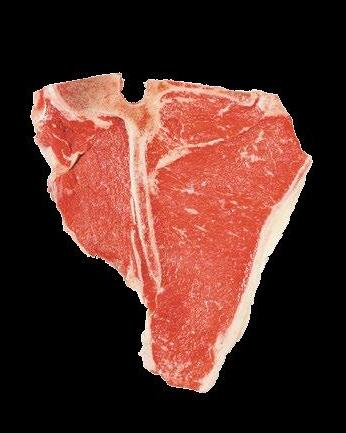

we need. But at the same time, don’t worry about whether you’re eating enough vitamins and minerals—if you eat a variety of wholesome, real foods, you’ll get everything you need. “Focus on foods and let the nutrients take care of themselves,” he says.
Eggs are OK in moderation as well. And don’t leave avocados, almonds, olives and salmon out of your diet, since they are high in healthy fat. They contain nutrients
Oils are another way to get more healthy fats in your diet. “The fats you use to prepare a meal are as important as the fats you take in,” says Govers. Healthy oils include olive oil, soy oil, peanut oil and rapeseed oil. Use coconut oil sparingly, though, as it’s loaded with saturated fat.
How can you tell whether your oil is a good choice? An oil that’s liquid at wrong for a while, Katz admits, going a little “overboard” in advising people to avoid fats completely, at the expense of healthy fats that we need, such as omega-3s in fish. “Painting with such a broad brush got us in trouble,” he notes. His advice today? Eat wholesome foods in sensible combinations and amounts. That means lean meats such as venison or grass-fed beef, both of which are low in saturated fat.
© YINYANG/GETTY (KALE),
41 09•2016 |
© DIANE LABOMBARBE/GETTY (STEAK)
room temperature tends to be better for you. “The problem comes when you have hard fats that are solid at room temperature,” Govers notes.
EAT LOCALLY
It’s no secret that foods grown locally are fresher. As a result, they usually taste better—and they can be cheaper too! But thinking about where your food comes from is an important part of eating in what Thul calls a “wholesome and substantial” way.
ONE VITAMIN YOU MAY NEED MORE OF
EVEN IF YOU EAT a balanced diet, there’s one nutrient that you may want to think about supplementing in your diet. Vitamin D is essential for bone health. The body gets it from foods in small amounts, and in larger amounts from the sun. Our skin actually uses sunlight to make vitamin D!
You might know you could be deficient if you live in a northern latitude. But even people who live in warmer climates don’t always get enough, Govers says. “In the southern climates people don’t go outside because it’s too hot,” she notes.
If you’re over 50, and especially if you’re a woman, speak to your doctor about whether or not you should take extra vitamin D daily.
“Substantial is more than just an organic way of growing; it’s also how far it comes,” she says. “Try to eat what’s growing in your country at the time.”
Of course, that’s easy to say in the summer. But even in winter, you can get the recommended five servings per day of fruits and vegetables. Frozen fruits and vegetables can be cooked, or made into a smoothie. Aim for three portions of vegetables and two portions of fruit every day, she says.
Helping people know how to eat healthily using foods available locally is one of the goals of the profession of dietetics. Groups such as the World Health Organisation, the UN and the European Food Safety Authority suggest what nutrients we need. Then it’s the job of people such as dietitians to translate the science of micronutrients and macronutrients into food-based recommendations.
“Each country has developed their own model for it and their own food content, to address the national population and to show them what the healthy choices are in the food that’s available,” says Govers. “The original idea is a worldwide idea, but in every country is a national guideline. They don’t differ much.”
GRAINS
Fibre is a nutrient that we get from several food groups: vegetables and fruits, but also from grains. Fibre
WHAT TO EAT NOW
42 | 09•2016
helps with bowel function and can help you feel full if you’re not used to it in your diet. It can also help your cholesterol and blood-sugar levels. It’s recommended for most people to eat around 30 grams of fibre a day, but that’s quite a bit, and many don’t do that, Thul says.
Look for wholegrains, she says: muesli, wholegrain breads, lentils and beans. Choose brown rice and wholegrain pasta whenever possible. And try baking with wholegrain flour. But don’t give up white flour all at once. “You need to get used to the taste of it,” Thul says. “When you have a recipe and you have 200g of flour, use 100g of white flour and 100g of wholegrain so you become accustomed to the taste.”
FOR CHILDREN
School lunches are often a focus when it comes to how children eat, since children spend so much time at school. But it’s about more than just what’s on their plate, says Maarit Laurinen, a food scientist based in


Finland who runs the online blog Kouluruokatietopankki (“School Lunch Data Bank”). “School lunch has its obvious nutritional values and benefits,” she says, “but school lunches can also contribute to food education, social well-being, sense of community, sustainable development and local food production.”
FOODS GROWN LOCALLY ARE FRESHER. AS A RESULT, THEY USUALLY TASTE BETTER AND CAN BE CHEAPER TOO
School lunches can help young people develop what some are calling “food sense”—the understanding of how our choices affect ourselves as well as our surroundings. In Finland, Laurinen says, which is one of two countries that guarantee free lunch to all pupils during compulsory school years, some schools occasionally provide “climate-friendly” meals such as vegetarian and organic lunches,
READER’S DIGEST
© SCIENCE PHOTO LIBRARY/GETTY 43 09•2016 |
or serve locally produced fish as an ethical and ecological alternative to farmed meat or imported fish.
But school menus in some places have a way to go, especially in light of rising rates of obesity among kids, Thul says. Many children are eating too much meat, just as adults are.
Laurinen notes that adding more fish to school meals (as well as home meals) is a good way to reduce the amount of red meat consumed.
Other advice for helping children eat better is, as with the advice for
WHATEVER YOU EAT, STOP WASTING IT
THE AVERAGE EUROPEAN wastes about 123kg of food each year, which amounts to about 16 per cent of all food that reaches consumers. And most of it could be avoided, according to a report* from the Institute for Environment and Sustainability, a wing of the European Commission’s Joint Research Centre.
Why should we care? It’s not as if our spoiled salad could be eaten by someone else. Instead, the report says, it’s an issue of sustainability. Approximately 27 litres of water per person per day are wasted because of that uneaten food.
*Based on data from the UK, the Netherlands, Denmark, Finland, Germany and Romania. Those six countries had the most complete data.
adults, not terribly new but with a new focus. The obesity epidemic— or endemic, which is the word Govers uses—is an issue in almost every country now.
Thul agrees. Get children to drink water, juice or fruit teas instead of soft drinks, she says, and be sure they eat enough fruits and vegetables so they don’t go looking for sweets. There’s an understanding that the way we feed children needs to change, she adds. “It has to, because the obesity problem is just becoming so severe.”
NAVIGATING FADS
The “latest and greatest” advice on how to eat is often coloured by fads. And fads have got us into trouble in the past. Low-fat junk food is one example Katz points to: it’s not a good idea to indulge in high-sugar, highcarbohydrate biscuits just because they’ve been engineered to have no fat. “We keep inventing new ways to eat badly,” he notes.
Many food fads are focused on the idea of strenuously avoiding one type of food or nutrient, sometimes at the expense of others—or at the expense of good sense. Thul points to the current vogue for gluten-free foods as one example. “Sometimes I stand in front of the package and think, It didn’t have gluten to begin with!” Same goes for “lactose-free” labels, she says. “When you buy a package of flour and it says it’s lactosefree, it’s confusing to people.”
WHAT TO EAT NOW
44 | 09•2016
Only a very small number of people legitimately need to avoid gluten, Thul says. “It doesn’t make sense to advise every healthy person to eat gluten-free or lactose-free these days.”
EAT WITH OTHERS
Each nation releases its interpretation of how its residents should eat, taking into account national concerns and issues. However, there’s one piece of advice in the guidelines from Brazil that people all over the world are joyfully embracing. Along with standard counsel to choose natural, minimally processed foods and eat
small amounts of salt and sugar, the guidelines also recommend eating in the company of others, and doing so in clean, comfortable and quiet places.
Why? “If you eat alone, you tend to eat more, you tend to eat unhealthily, or you tend to skip essential parts of the meal, like vegetables,” explains Govers. Even if you live alone, try to eat with friends or family two or three times a week. “That’s the thing about a meal. It’s not only the food but the context,” Govers says. “Food is not only about nutrients. It’s also about being loved and loving back.”
PROFESSIONAL STRIFE
We all have work woes. The glory of Twitter is that we can share them:
“Don’t you just hate it when you arrive at work and realise you’ve forgotten to bring your will to live?”
“We all have this colleague who, we hope, quits his job so everyone in the office is happy. If you don’t know any such person, quit your job.”
“I told all my colleagues that I have a twin so when I see them in public I don’t have to talk to them.”
“Co-worker: ‘Do you ever think about work at home?’ Me: ‘I don’t even think about work at work.’ ”
“Adorable idea. Colleagues have been writing names on their food in the office fridge. I’m currently eating a yogurt called Debbie.”
“You can sit idle for days in your office, but the moment you ask for half a day’s leave, you become strategically the most important employee.”
“We all had to sign a card for a co-worker that’s retiring and I just wrote, ‘Please take me with you.’ ”
SOURCE: BOREDPANDA.COM (READ MORE AT READERSDIGEST.CO.UK/PROFESSIONAL-STRIFE)
45 09•2016 | READER’S DIGEST
An Egg-cellent Start To The Day

Susannah is twice winner of the Guild of Health Writers Best Consumer Magazine Health Feature
The holidays are over and it’s time to get back into the old routine—and that starts with a good breakfast.
WHy brEAkfAsT is THE mosT imporTAnT mEAL of THE dAy For starters, you’ve spent all night fasting and you’ve now got a busy day ahead, so you need energy. Think of breakfast as fuel—it doesn’t make sense to start the day on empty. Not only that, but there’s a strong link between diet and emotional health. A healthy breakfast provides nourishment for the brain and nervous system. Eat well early in the day and you’ll feel better for the rest of it.
bEsT foods To sTArT THE dAy Porridge is full of fibre and low in saturated fat and cholesterol, while fresh fruit and lowfat yogurt give you calcium, protein and at least one of your five a day—but eggs are hard to beat. Eggs are high in protein, vitamins and minerals, and they’re only 70 calories a pop. They contain vitamins A, D, E and B12, while on the mineral front you’ll get iron, folate, selenium and choline. This scramble of nutrients helps you maintain healthy skin, bones and teeth, and may even protect against some cancers, heart disease and autoimmune disease (where the body turns on itself in diseases such as rheumatoid arthritis and psoriasis).
| 09•2016 46 HEALTH
b y sus A nn AH H ick L ing

smAsHing THE cHoLEsTEroL myTH But aren’t eggs full of cholesterol, ready to fur up our arteries? Apparently not. That claim was later contradicted by a review of research. This found that eggs caused a small but clinically insignificant rise in blood cholesterol. So there’s no need to restrict your consumption. In fact, the saturated fats found in red meat and butter are much more likely than eggs to increase your cholesterol.
THE pros And cons of THE grEAT briTisH brEAkfAsT The healthiest way to eat eggs is poached, boiled or scrambled (though go easy on the butter with the latter option), and of course we’ve nothing against nutrient-stuffed tomatoes or baked beans (low in fat and high in protein and fibre), but you might want to keep sausages and bacon as an occasional treat. Not only are they brimful of saturated fats, but processed meats have also been flagged as a risk factor for bowel cancer.
skin dEEp
how do you knock
20 to 30 years
off your age? With regular exercise, say canadian researchers from McMaster university, who claim that it helps preserve your skin. how? it seems that working up a sweat for 30 minutes twice a week can actually help prevent the dermis (the tissue just underneath the top layer, or epidermis) from thinning out and the stratum corneum (the outer layer of the epidermis that you actually see) from thickening—thus

rEA d E r’s d ig E s T ©
O va/shutterst O ck
Olga Milts
© Maridav/shutterst O ck
Diseases That Doctors Dismiss
cHronic fATiguE syndromE “All in the mind” is the verdict of some in the medical profession when it comes to conditions like CFS. But try telling that to the sufferers! They’re often beset with persistent exhaustion that sleep doesn’t improve. Last year the US National Institutes of Health released a report, which laid out in plain language that CFS actually exists. Cognitive behavioural therapy and medication for pain may be helpful.
fibromyALgiA
Sufferers have muscular pain all over their body, poor-quality sleep and exhaustion. It affects more women than men. There’s no cure, but antidepressants, painkillers and cognitive behavioural therapy can offer relief.
morgELLons
Morgellons is not recognised as a disease in the UK, but last year it was announced that singer Joni Mitchell is a sufferer. Symptoms include skin-crawling and biting sensations, itchiness and skin sores with tiny fibres emerging from them. It’s often considered to be delusional, though research has found that the fibres are made of human skin cells. A healthy diet and exercise may help.
opEn your EyEs To bETTEr HAbiTs
We only have one pair of eyes, so if you indulge in these bad practices, you may want to consider changing your ways:
1. Being a screen junkie. too much time gazing at your computer, tablet or smartphone can strain your eyes. try to follow the 20-20-20 rule: every 20 minutes, look at something 20 feet away for 20 seconds. this helps reset the focus of the eye.
2. Sleeping in lenses. Your risk of an ulcer or serious infection in your eyes leaps if you leave contact lenses in when you go to bed. there
are even tales of people losing their sight as a result. always take your contacts out at night and wash them in a special cleaning solution.
3. Skipping eye tests. these aren’t just about eyesight. they can reveal health issues such as type 2 diabetes, high blood pressure and creeping eye conditions such as glaucoma. Make sure you go for one every two years.
4. Smoking. chemicals in tobacco smoke can damage your eye, raising the risk of age-related macular degeneration, a cause of blindness in older people, and cataracts.
h ealth | 09•2016 48
health
Metabolism Matters
Middle-aged spread? spare tyre? l ove handles? Call it what you will, a lagging metabolism can be a problem as you get older.
Q. doEs our mETAboLism
rEALLy sLoW doWn? A. It does. Firstly, it’s likely to be part of the natural ageing process and, secondly, we have less muscle as we get older. Muscle is more metabolically active than fat and so needs more calories. With less muscle, you need less food.
Q. HoW cAn you firE iT up AgAin? A. The best way to boost metabolism is to remain active and maintain muscle mass. Lifting weights seems to be particularly good at raising metabolic rate, but heavy gardening at least twice a week might do the trick too. As we get older, we also need to change our eating habits to avoid weight gain. We should eat smaller portions, plus snacks if meals are more than four hours apart.
Q. WHAT ArE THE bEsT snAcks
To boosT mETAboLic rATE? A. Munch on a piece of fruit and a small handful of raw, unsalted nuts. Mix it up for variety—pair an apple with almonds, pineapple with macadamia nuts, or a pear with pumpkin seeds.
mEn’s HEALTH: suicidE WATcH
According to the Mental Health Foundation, four times as many men as women commit suicide. Here are some warning signs to look out for:
■ Feeling depressed and anxious.
■ loss of interest in hobbies, work, friends or the way you look.
■ a sense of hopelessness.
■ acting impulsively or recklessly.
■ giving away possessions.
■ talking about suicide or death to family, friends or health professionals. this can happen in the year before a person attempts suicide.
But suicide can be prevented. if you’re afraid that someone you know might try to take their own life, it’s important to help them seek help. Being understanding and willing to talk to someone in distress is a first step. For those feeling suicidal, going to a&e or calling 999 can lead you to the immediate support you need. calM, a national helpline for men, is available seven days a week (0800 58 58 58), while the samaritans are there 24/7 on 116 123. calls are free.

09•2016 | 49 rEA d E r’s d ig E s T
© kurhan/shutterst O ck
It’s The Thought That Counts
By max pem B erton

Max is a hospital doctor, author and newspaper columnist
“WoW. it’s a...it’s a...” Words at this point begin to fail me. I look perplexed as I try to work out exactly what it is. “Gallstone,” Mrs Lawson interjects, helpfully.
I look down again at the small grey pebble clasped between my finger and thumb and stop holding it quite so hard. In fact, I feel a little ill and put it back in the box. It seems rather unbelievable to say that it’s what I’ve always wanted. I stand there open-mouthed instead.
“I thought you could have them made into a pair of cufflinks,” she adds. I look in the box and, sure enough, there’s another little beauty staring up at me, roughly the same size as the first.
“Well, that’s very thoughtful of you,” I say, still a little stunned. I put the lid back on the box and rush to the sink to wash my hands.
i’m not going to pretend this is a normal present to give your doctor, or indeed anyone. It’s plain weird. In a way I can understand Mrs Lawson’s logic—she has schizophrenia and was in my clinic several months ago to review her antipsychotic medication. She mentioned her abdominal pain, and after examining her, I referred her back to her GP for some tests, suspecting that it may be gallstones.
And clearly it was. By way of a thank you, she’s brought them today. Really, a box of York Fruits would have done.
| 09•2016 50 H ea Lt H

However, presents are few and far between when working in psychiatry, so you’re grateful for them when you get them.
Sort of. While there may be a lack in quantity, there’s certainly no lack of imagination in the gifts I’ve received. There’s the cat collar, which would have been very useful if I had a cat. There was the rather worrying copy of One Flew Over the Cuckoo’s Nest, complete with authentic, clearly psychotic annotations in the margins. There’s also been a biro (used) and a single boiled sweet (unwrapped, with fluff attached). The best present was a bottle of very expensive champagne, but we soon discovered that the patient was having an acute manic episode and had shoplifted it, so we had to return it.
In other areas of medicine, of course, doctors tend to get given the standard fare: boxes of Roses. When I worked in surgery, we were inundated with chocolates, although if ever we ran out and were hungry, we’d find an excuse to go to the obstetric ward—a very high chocolate quota there. In psychiatry, where a number of patients don’t even think there’s anything wrong with them, you’re sometimes lucky to get a hello.
But, actually, I rather like the presents I’ve received while working in mental health. While they may be unconventional, they’re far more personal than a box of Milk Tray. And anyway, looking at Mrs Lawson’s gallstones, I’ve suddenly lost my appetite altogether.
I on BY
09•2016 | 51
Illustrat
Geor GI e Fearns
meDICaL mytHS—BUSteD!
You Can Cure A Hangover

WHere DID tHe mytH Come From?
Anyone who’s had a hangover will know how truly soul-destroying it is. There’s nothing else like it on earth. So is it any wonder there’s a slew of home remedies and old wives’ tales about how to cure it? From orange juice to Marmite through to a fried breakfast or a raw egg, the alleged cures are endless.
But I’ve got bad news for all of you who have over-indulged: despite thousands of years of human beings consuming alcohol—despite all the incredible discoveries—we’ve yet to find an effective cure for a hangover.
WHat’S tHe trUtH?
A large randomised trial looked at a number of remedies, from foods and complementary therapies through to prescribed medication. Nothing was shown definitively to work. Hangovers are actually caused by a number of factors, including dehydration (as alcohol acts as a diuretic, causing fluid to be excreted). Certainly ensuring you’re properly hydrated will help, as will taking painkillers such as paracetamol.
So tHere’S no Hope?
The first thing to remember is that hangovers do pass. Your liver works incredibly hard to detoxify the alcohol you’ve consumed, and gradually your body will excrete all the toxins and you’ll rehydrate yourself. Drinking on a full stomach may reduce the rate at which alcohol is absorbed, meaning that your body is given extra time to deal with it. However, a hangover is your body’s way of telling you that it’s struggling to deal with your overindulgence. Listen to your body and next time limit the amount of alcohol you consume.
Illustrat I on B Y D a VID H u MPH r I es | 09•2016 52 H ea Lt H

The Future of Care: Part One
Make Yourself At
Home
In the first of a three-part series looking at the issues surrounding care in Britain, Eimear O’Hagan investigates the new breed of age-exclusive developments that are giving retirees an exciting alternative to the traditional nursing home
© Te T ra Images/ a lamy sT ock Pho T o
54 INSPIRE

WhEN my wIfE hEathER dIEd in May last year, aged 81, one of my greatest worries about continuing to live in our three-bedroom bungalow, was that I’d become lonely,” says 82-year-old Arthur Hunt, a retired chartered engineer. “Also, having cared for my wife for three years before her death, because she was unwell, I didn’t want my daughter Jenny—who’s married with a busy job—to have to care for me if my own health declined.”
For previous generations of retirees, it was often seen as inevitable that a point would come in their life where independence became a thing of the past. They submitted to their fate, selling their cherished family home to pay nursing-home fees, or allowing strangers into their house to provide practical help without companionship. Indeed, “care for the elderly” evokes images of straight-backed armchairs in gloomy nursing homes, or a frail pensioner stuck indoors, with just fleeting visits from a carer to relieve their isolation.
these days, however, the UK is seeing a shift away from traditional care options towards “assisted living”, with “age-exclusive” residential developments springing up across the country. These offer 24/7 support while preserving independence and control of one’s affairs.
Around one third of the British property market is owned by the over-60s, and as a society more of us are living longer than ever before— with the number of over-75s predicted to increase by around 95 per cent in the next 25 years. For many, with age will come a reluctance or an inability to continue living in a large family home, and downsizing will become essential or appealing.
“A few months before she passed away, Heather had encouraged me to consider moving when she was gone,” continues Arthur. “She felt it would be too much for me to look after the house and garden on my own. Knowing I had her blessing, I began looking into what was available for someone like me—who was in good health and didn’t need nursing care, but who wanted companionship and the comfort of knowing help was nearby if I wanted it.”
With interest rates so low, Arthur didn’t want the proceeds from his house sale doing nothing in a bank account. Instead, he wanted to invest in another property as an investment for his daughter. It was then he came across an assisted living development in Soulihull, west Midlands.
“I’d never heard of these before, so I was intrigued. It ticked all the boxes, plus I could continue to own my own home.”
Arthur duly moved into the development last September, after buying a two-bedroom apartment.
| 09•2016 56 make yo U rsel F a T home
“

so what exactly is assisted living? Put simply, it’s a property you own, situated within a purposebuilt, secure community, with social outlets and support available when or if you need it—a choice beyond the traditional care home.
Apartments have alarms linking residents to full-time staff in case of an emergency such as a fall, and there are on-site restaurants, gyms, cinemas and allotments. Depending on the development, extra support— ranging from carers and trained nurses to cleaners and handymen— can also be arranged.
Lorena Brown is the marketing and sales director of Pegasus Life,
a retirement housing company that specialises in bespoke village-style developments for the over-60s.
With two sites now fully occupied, in Bude, Cornwall and Woodbridge, Suffolk, and over 30 more in the pipeline (such is the demand), she says they’ve identified a previously neglected type of retiree.
“The traditional care sector hasn’t been doing enough to meet the expectations of this discerning older generation. Retirement is now seen as a ‘next chapter’, and a time to be enjoyed,” says Lorena.
“A consequence of that changing attitude is that expectations are higher, people are more aspirational
09•2016 | 57
©
U s l IF e
Residents enjoy a cup of tea at Atlantic Rise in Bude, Cornwall
Pegas
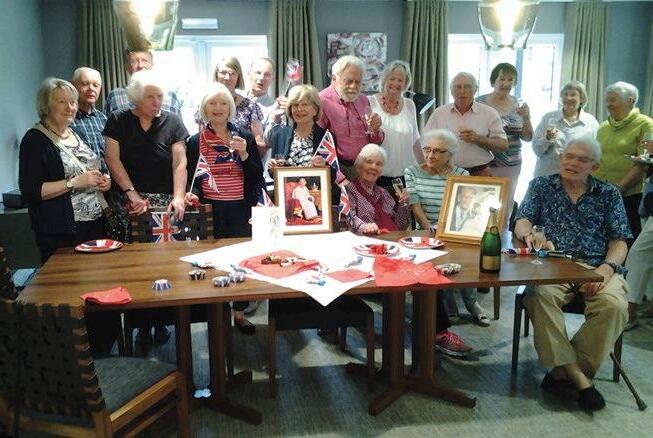
Celebrating the Queen’s 90th birthday in Solihull
and they want where they live, and how they live, to be of a high calibre.
“Needing some support, or wanting to downsize, doesn’t mean they’re prepared to sign away their liberty or compromise their usual standards,” continues Lorena. “This generation recognises the value of ‘future-proofing’, so while they may not need any practical support at the moment, they know that time may come and they want to be living in an environment where they can easily access it.”

Sixsmith, professor in public heath and implementation at the University of Northampton, believes they have the potential to offer residents some psychological benefits too.
i n addition to the obvious practical benefits of life in an “AL” development, psychologist Judith
“Belonging to a community (which is what these places can offer if the social and psychological meanings of environment are attended to),
| 09•2016 58
© Pegas U s lIF e / m c c ar T hy & s Tone make yo U rsel F a T home
Liberty House in Raynes Park, London, offers assisted living with a roof terrace
alongside positive interaction with other residents and staff, can have great benefits for people’s wellbeing,” she says. “They can feel that they’re a worthwhile part of society and as a result, they can feel happier, more purposeful and valued. If you’re isolated, your self-esteem can diminish, and people who are lonely can experience poorer physical and mental health.”
“Also, it can be a huge psychological wrench to leave the home you may have lived in for many years to move somewhere new. If you’re someone for whom it’s important to have a ‘home’, as opposed to just a place to live, then the idea of continuing to own your property, having your own furniture and belongings in it, and being in control of who comes and goes, will likely appeal to you.”
David Bridges is the customer experiences director at McCarthy & Stone, one of the UK’s leading retirement housebuilders, which has 75 developments across Britain. According to David, several factors are fueling the demand.
“We’re a nation of homeowners, and increasingly people are reluctant to lose that status. They also want to have an investment that they can leave to their children or grandchildren. They may want to downsize, or not feel able to maintain a large family home any more, but they don’t want to give up owning their own property,” he says.
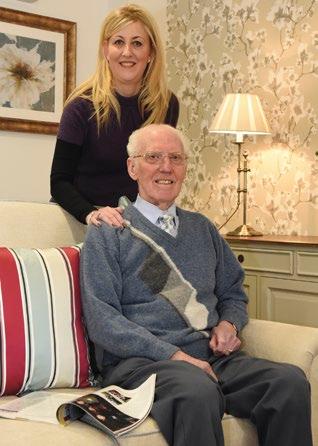
Arthur Hunt with his daughter Jenny.
“I couldn’t have predicted how enriched my life would become”
“Also, we find that many of our residents have had very successful careers. They’re people who have always been in control of their affairs, and the idea of giving that up is very unappealing. Life in a traditional nursing home isn’t for them; they don’t want to have to eat and go to bed at set times, be forced to socialise if they don’t feel like it, and although they may want the comfort of knowing support is on hand, they don’t need to be nursed or taken care of all the time.
“Assisted-living developments give them choice and that’s a strong
09•2016 | 59 R E ad ER ’ S dI g ES t

Assisted-living residents take part in a painting workshop
driver behind this trend,” says David. “They can choose to cook in their own kitchen, or dine with other residents in the dining room. They can join in with organised activities, such as art classes or trips to stately homes, or they can relax in the privacy of their own home. And they can come and go, and entertain friends and family, as they please.”
t he younger generation are also influencing this trend. Today’s adult children are part of the “sandwich generation”—stuck between their careers, their own families and caring for their ageing parents—seeking out a solution.
“Often it’s the grown-up kids who make the first contact with us,” agrees Lorena Brown. “They want to help their parent find somewhere safe and comfortable to live, so there’s less pressure on them and they can just enjoy their time with their parents, rather than be anxious about their wellbeing.”
Far from approaching our twilight years with a sense of trepidation, about a loss of independence and limited options should we need practical support, the popularity of assisted living is offering UK retirees another way to live happily and with confidence. For Arthur Hunt, it’s meant a new lease of life.
“We play bridge and bowls, hold quizzes and had a party for the Queen’s 90th birthday earlier this
| 09•2016 60 m ake yo U rsel F a T home
© B el U sh I/ sh UTT ers T ock
“We want to make the most of these years”
Lilian heard 83, is a retired dental hygienist. She talks about her life in an age-exclusive development in woodbridge, Suffolk.

“When I told my daughter and four grandchildren that I was planning to sell my home and move into a retirement development, they were concerned. They thought I meant I was moving to an old people’s home. I may be in my eighties but I play golf regularly, use a computer and love to socialise and travel.
I reassured them my new home, a modern two-bedroom apartment, was not like they’d imagined. It’s set within a new development—more like a village—with 29 unique apartments. residents are a mix of singles, couples, widows and widowers.
I was widowed six years ago when my husband David passed away. as time went on, I realised I needed to downsize. our home, where I’d lived
year,” he says. “I can be as sociable as I choose. There’s also 24/7 assistance should I take a fall or feel unwell, and if I reach the stage where I need help washing or dressing, I can pay for a carer to come in.
“I see my daughter several times a week and we can just enjoy our time together. She knows I’m happy and
for 22 years, was too big and I had to drive to get anywhere. I’m fortunate to be in good health—plus after a lifetime of working and travelling the world, including living in Japan, I wasn’t ready to give up my independence. my development has wonderful shared facilities including a gym that’s been designed for older people, a cinema for watching films and sport, and a communal lounge where we throw parties and entertain friends. It’s a seven-minute walk to the market town of Woodbridge. I still use my car, but for pleasurable trips, not as a necessity.
I didn’t want to feel I was in a ‘care’ environment. I have the support of new friends around me and the development’s staff, which is very reassuring. my generation lived through the war, we’ve worked hard all our lives and we want to make the most of these years, which I know I will certainly do here.”
safe, which gives her peace of mind, and I enjoy staying independent. I miss Heather terribly, but the friendships I’ve formed and staying busy has really helped me. I’m sure she’d approve of the move I’ve made.”
Next month, why homes with separate “granny annexes” are on the rise.
09•2016 | R E ad ER ’ S dI g ES t
61

A Pension That Lasts A Lifetime
THERE'S A SKILL in finding the correct balance between living comfortably today and preparing for the future, especially when it comes to those in retirement who are living for an uncertain period of time on a fixed pension. The fear of outliving their money is a very real concern facing a large proportion of retirees today.
Home equity is being factored
into retirement planning as a way to alleviate the fear of running out of the money required to live comfortably. Your property can help provide a backstop to your traditional pension savings.
One of the options to access this wealth in your property is a lifetime mortgage. It allows you to draw tax-free money from your property in an initial
PARTNERSHIP PROMOTION
lump sum, with the option to take more in smaller amounts and as when required. These lifetime mortgages don’t usually come with monthly repayments, though with some you have the option to make repayments if you wish. There's no fixed term on the mortgage as they're designed to run for your lifetime.
A lifetime mortgage is available to UK homeowners aged 55+ and you can spend the money as you wish. It’s important to remember that by taking equity out now, there will be less to leave as inheritance.
To find out more...
...and discover how you can unlock the wealth tied up to your property, request the Reader's Digest Guide to Equity Release by calling 0808 168 9297.
Visit readersdigest.co.uk/ equity-release to instantly find out how much you can release.
MONEY
HOW DO OUR CUSTOMERS USE A LIFETIME MORTGAGE?
Some customers use them in smaller amounts to provide a safety net and comfort factor, knowing that they have the option to draw cash on a rainy day and to top up income. It helps their fear of running out of money in retirement and allows them to plan accordingly.
Other customers use them to clear debts and free up the cash that is spent repaying debts every month.
Many people are using them to provide an early inheritance to loved ones—and being able to see first hand the impact and help that they are able to give to their family or charitable causes.
While some customers kickstart those home-improvement projects, others use it to be happy in the comfort of knowing their holidays and travel plans are booked and on the horizon.
A lifetime mortgage may affect your entitlement to means-tested state benefits. To understand the features and risks, ask for a personalised illustration. Retiredom provides initial advice at no cost and with no obligation. Only if you choose to proceed and your case completes will we charge an advice fee, currently not exceeding £1,295.

INSPIRE 64
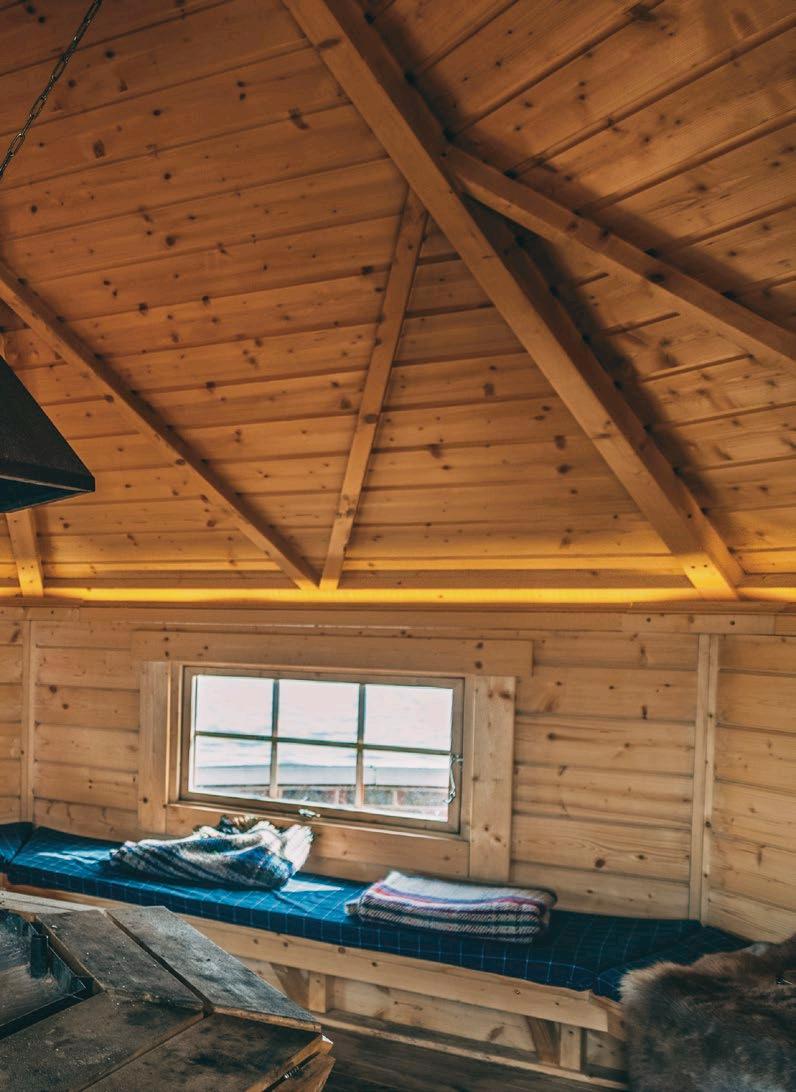
Best of British
Converted Spaces
Fond of a fixer-upper?
These digs give new purpose to historical locations
By f I o N a h I ck S
Spitbank Fort haMPShIRE
Once under the jurisdiction of the Royal Commission, this 19th-century structure is bizarrely yet brilliantly one of the most opulent spots around.
Situated just off the Portsmouth coast, the 50m-wide construction was completed in 1878 to protect the harbour from attack by Napoleon III. It remained in use until 1962, when it was declared surplus to requirements and disposed of by the MoD.
It’s now been renovated as a luxury venue space. Gone are the guns, and among the many perfectly appointed rooms you’ll find a library, a wine cave and a selection of bars. There’s even a hot tub and a fire pit.
It’s a popular destination for lunch trips, as well as weddings. Enjoying panoramic views while soaking in the rooftop pool? There are worse ways to begin a honeymoon.
■ Visit amazingvenues.co.uk for details


Appleton Water Tower NoRfoLk
In 1871, the Prince of Wales fell ill with typhoid while staying at the Royal estate of Sandringham. An engineer was despatched to investigate and found there to be a number of dirty cesspools polluting the castle’s drainage. Clean water
| 09•2016 66 best of british
© amazingvenues.co.uk

became a noble necessity and a tower was duly built—the happy outcome of which was a new and magnificent viewing point for the estate, plus much of Norfolk.
The engineer in charge, James Mansergh, wisely opted to leave the second floor as a platform for the Royal clan to enjoy the vista. Today,

the floor has been converted into a charming two-bedroom apartment that’s available to rent for short stays. Each room is beautifully furnished, the setting is peaceful and the view of the sunset is, well, royally good.
■ Visit landmarktrust.org.uk for details
R E ad ER ’ S dI g ES t 09•2016 | 67
© landmarktrust.org.uk
This historical tower once played host to the Royal family
Tamesis Dock
LoNdoN
“Tamesis is a unique conversion in an even more unique location,” says proud co-owner Neema Rai. Anyone who’s acquainted with Vauxhall, London, knows this is the place to head for a rollicking night out. The former Dutch barge is a glorious blend of settings: part pirate ship, part good old pub—with a hint of themed nightclub thrown in.
However you see it, there’s plenty of merriment to be had. Drinks flow (which can make meandering the wonky floor a fun challenge) and live music plays while the Houses of Parliament look on.
It also serves some rather decent nosh, so it’s a great place for a spot of lunch during the day, when it tends to be a bit quieter. The nachos are worth a try, as is the Tamesis burger. Health-conscious folk can even opt for the vegan Scotch egg.
■ Visit tdock.co.uk for details
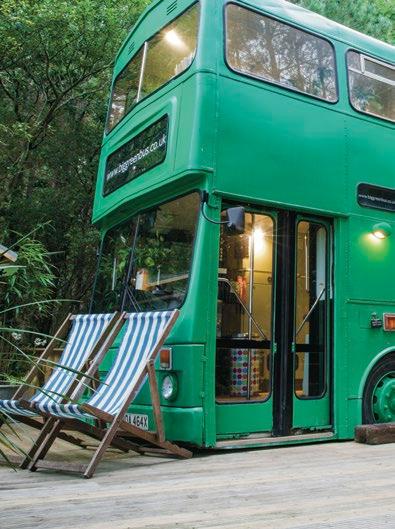


Big Green Bus St SUSSEX
One creative couple decided to turn this West Midlands Metro Bus into a rentable holiday space. Sleeping six, there’s a fully-fitted kitchen, a wet room and loo, and even a log burner.
“With 689,000 miles on the clock, it had travelled the equivalent distance from the earth to the moon, back, and
best of british © tamesis d ock
This conversion appeared on Channel 4’s George Clarke’s Amazing Spaces

then halfway to the moon again!” says Adam Colliers-Wood, a trained carpenter who carried out much of the work himself. “It was destined for the scrap heap when I bought it, but it’s now enjoying a leisurely retirement in Sussex.”
Both Brighton and Lewes are a short drive away, and there’s the welcoming Six Bells pub within walking distance. If you can’t bear to leave the delights of the bus, you can even arrange to have a hamper full of local produce—plus a bottle or two of wine—ready for your arrival.
■ Visit biggreenbus.co.uk for details
Wendy the Aberporth Express WaLES
From boats to buses to trains… the delightfully named Wendy the Aberporth Express is a good reason to venture to the west coast of Wales. Once voted one of the top five spots to enjoy the seaside, this Edwardian railway carriage looks out over Cardigan Bay, with a mesmerising aspect of the Irish Sea.
The carriage is a cornucopia of creature comforts. A woodburner in the salon, a hairdryer in the bathroom and a heated towel rail in the bathroom make it easy to settle down for a cosy night in. Despite its blustery coastal position, the carriage is lined with oak, insulated and panel-heated, which means that it’s always snug.
Wander out on to the deck, cup of tea in hand, and you might even be able to spot dolphins in the distance if you’re really lucky.
■ Visit underthethatch.co.uk/wendy for details

R E ad ER ’ S dI g ES t 09•2016 | 69 © biggreenbus.co.uk / uniqhotels.com

Shepherd’s Hut yoRkShIRE
many a couple has visited here for a romantic and rustic getaway. “We only have the one hut,” says Fiona Sanderson, whose husband is the hill farmer at Bilsdale. “We want people to come and really feel that they’re

Essentially a snazzed-up shed, this is a fantastic place to stay for those wishing to get back to nature. The hut, made by local craftsmen, features a cleverly and comfortably designed bedroom, plus a little adjoining barn with a bathroom and a kitchenette. Entirely secluded,
by themselves, not bumping into other people when they’re here. We get a lot of people coming for birthdays, anniversaries and short breaks, just to get away from everything really.”
There are sweeping views across the fields and—because it’s situated on the working hill farm—it’s not unknown for a lamb or two to appear at the door to say hello.
■ Visit shepherdshutbilsdale.co.uk for details
| 09•2016 70 © shepherdshutbilsdale.co.uk
Lambs have been known to appear at the door of the shepherd’s hut
So for the home owner it really does look like a win-win situation but there are of course some drawbacks.

Despite the many advantages, conservatories in general are not very thermally efficient. This can result in situations where the cost of heating is extremely high in the winter and reducing the summer heat gain is next to impossible.


The down side to the roof replacement method is that one may need to obtain building regulations approval, the cost of the replacement roof system will be quite high and it is not a very quick installation.
Many conservatory owners have, over the years purchased blinds in an attempt to deal with this very problem and although they do offer some small benefit, they are largely ineffective. servatory usable every day of the year.


The upside of the roof replacement is that a conservatory with an existing roof that is beyond economic repair can be given a new lease of life.
On the other hand, if the existing roof is serviceable, then having an insulated ceiling installed will convert the conservatory into the beautiful haven that had been hoped for but at a fraction of the


complete peace of mind.” Our thermal conservatory ceiling insulation is highly efficient, cost effective and normally takes just one day to fit.
•Reduces heat loss by up to 95%
•No planning permission needed
•Government Approved 5% VAT
•Professionally fitted usually in just 1 day
•Free No-Obligation, No-Pressure Survey





Don’t suffer another winter of freezing conditions or endure another summer of unbearable temperatures. Our thermal conservatory ceiling insulation is guaranteed to transform your too cold, too warm conservatory into a beautiful, cosy living space for you and your family to enjoy all year round. No planning permission in required and our expert fitters will complete the installation usually in just one day. Because of its excellent energy saving capabilities we have approval from the government to reduce the VAT rate to 5% and if you quote RD238 you will also receive a further 20% discount off the list price.


“The difference your workmanship has made is nothing short of astonishing. Your construction team achieved exactly what we’d been after for years and had been repeatedly told it could not be done! ”
Mr & Mrs S - Coventry

twenty has growth domestic is that certain they great eneasing laws regulations, are their any red applying con-
Rundle & Dorey Ltd CONSERVATORY INSULATION SPECIALISTS 024 8860 www.rundleanddorey.co.uk Transform Your Conservatory Insulated Conservatory Roof - Fad or Necessity? We look at the facts. Advertisement room for all seasons Attractive & Energy Efficient Conservatory Roof Insulation - without replacing your roof Don’t suffer another winter of freezing conditions or endure another summer of unbearable temperatures. Conservatory ceiling insulation by Rundle & Dorey will give life to your beautiful living space so that it can be used all year round. You will love the look of your new vaulted ceiling which with it’s plastered finish, beautifully matches the ceilings in the rest of your home and saves you money on heating bills. 10 year Insurance Underwritten Guarantee Affordable Solution Reduce heat loss by up to 90% No planning permission needed • Installed in 1 day • Fully insured • Cool in summer • Government approved energy saving product, VAT just 5% ClaimHURRY! Your £500DiscountToday!VoucherLimited Offer! Call today for your FREE brochure and no obligation quotation! Ever thought about insulating your existing conservatory roof? Then look no further... Rundle & Dorey Leading the way in conservatory roof insulation! With 100’s of Satisfied Customers “You’ve absolutely nothing to worry about, at Rundle & Dorey our trained staff will take care of everything, from
to
start
finish for
BEFORE AFTER 10 Year Insurance Backed Guarantee
For a
Brochure, FREE Survey & 20% Discount Call 0800 024 8860 Visit rundleanddorey.co.uk Quoting RD238 20% Don’t miss out Quote Code RD238 DISCOUNT With 100s of Satisfied Customers
FREE
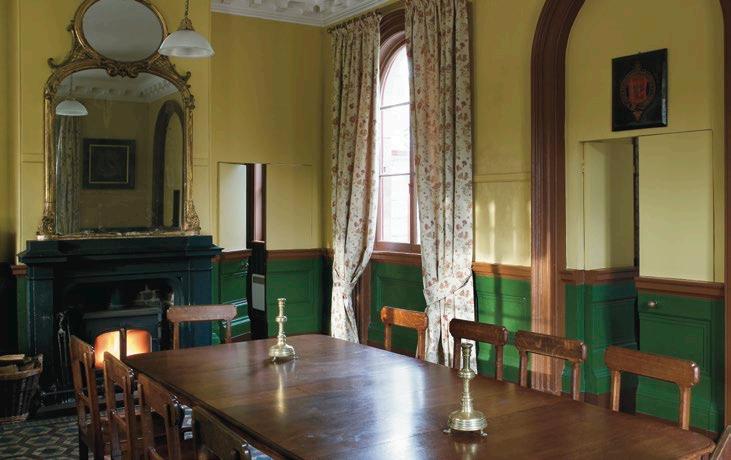
Alton Station
StaffoRdShIRE
This area is now famous for its theme park, but in the 19th century a station was built for the Earl of Shrewsbury, then owner of Alton Towers, to connect his estate to The Potteries and beyond.
The railway has long been out of use, but the station itself has been lovingly renovated as holiday accommodation. The lengthy restoration wasn’t without incident, though: rumour has it that a disused flue was found to be blocked with porters’ waistcoats!
All challenges overcome, the property now comfortably sleeps eight, with one of the double

bedrooms inhabiting the space that was once the ticket office (and there’s something strangely compelling about relaxing in a space that was once a hub of activity). Dogs are welcome too—and with the bucolic Staffordshire landscape easily accessible, it’s the perfect area for a relaxing ramble.
■ Visit landmarktrust.org.uk for details
do you know a brilliant converted space? Email readersletters@readers digest.co.uk and tell us about it!
best of british | 09•2016 72 © landmarktrust.org.uk

Steve Jones, 72, is emeritus professor of human genetics at University College London and a leading science communicator on evolution and genetics. He’s also a prominent broadcaster and writer.
If I Ruled the World Steve Jones
All pubs would revert to their original names. I don’t like this absurd fashion of calling them after the chains that own them. My local was called The Fox, after the charismatic politician Charles James Fox (1749–1806), but is now The Slug and Lettuce. It feels like a bit of history has been thrown out the window.
I’d make all school leavers work in a factory for a year. That was the best thing I ever did in my life. It knocked any thoughts of my own superior cleverness out of my head and taught me to value other people’s skills. When I was at university, students would often earn cash by doing physical jobs over the summer months. But nowadays, with the cheap labour available, that rarely happens. That’s a shame as spending a couple of days pulling potatoes out of the ground quickly made one realise just what a privilege it was to be at university.



INSPIRE | 09•2016 74
i LLU
strated by James s mit H
I’d give free travel passes on all public transport to anyone who sold their car and promised not to buy another one. The savings made with the reduction in pollution and accidents would go towards improving the public transport systems. Being a person of a certain age, I now have a travel card—and within a year I realised I didn’t need a car at all in London and sold it.
British public schools would be closed down. I’ve said before that they’re a cancer on the education system—indeed, I believe they rot our entire society. If I had my way we’d simply have an all-inclusive education system, regardless of money or class.
I’d ask people to consider what it would take for them to change their religion. Every religion believes itself to be the one true religion. Yet over the course of history there have been some 5,000 distinct religions. As Richard Dawkins pointed out: if we don’t believe in 4,999 of those, why would we rationally believe the last one? I believe in the freedom of religion, but I think everyone should study at least another one or two to get an objective perspective.
University bureaucracy would be reduced by 90 per cent. I teach at University College in London and the other day I noticed that the clocks
in the lecture halls had all been removed. Why? Apparently it took too long to service them. The person who made this mad decision had obviously never given a lecture in their life because if they had, they’d know how vital it is to have a clock at the back of the room that enables you to maintain eye contact with your audience while gauging the length of your lecture. We’re inundated with similarly frustrating decisions made by self-styled experts who are no experts at all.
Schools would start at different times for different ages. Our body clocks are far more in control of our lives than we once thought, and optimal waking times change throughout our life. The waking time for a teenager is considerably later than that of a child or adult. So it’s a bad idea to try and get teenagers to school too early—they’ll be sleepdeprived and unable to concentrate.
Everyone would get outside more. These days we’re outside less and less, but nothing makes you feel better than getting into the natural daylight. Now I don’t have a car, I walk to work—that half hour is a wonderful way to start each day. As told to Caroline Hutton
Steve Jones’s new book No Need for Geniuses, published by Little Brown, is out now.
09•2016 | 75

Solo Shepherdess The
By JACK WATKINS
Little Bo Peep? Hardly. Meet the 20-something who’s redefining the modern shepherding profession
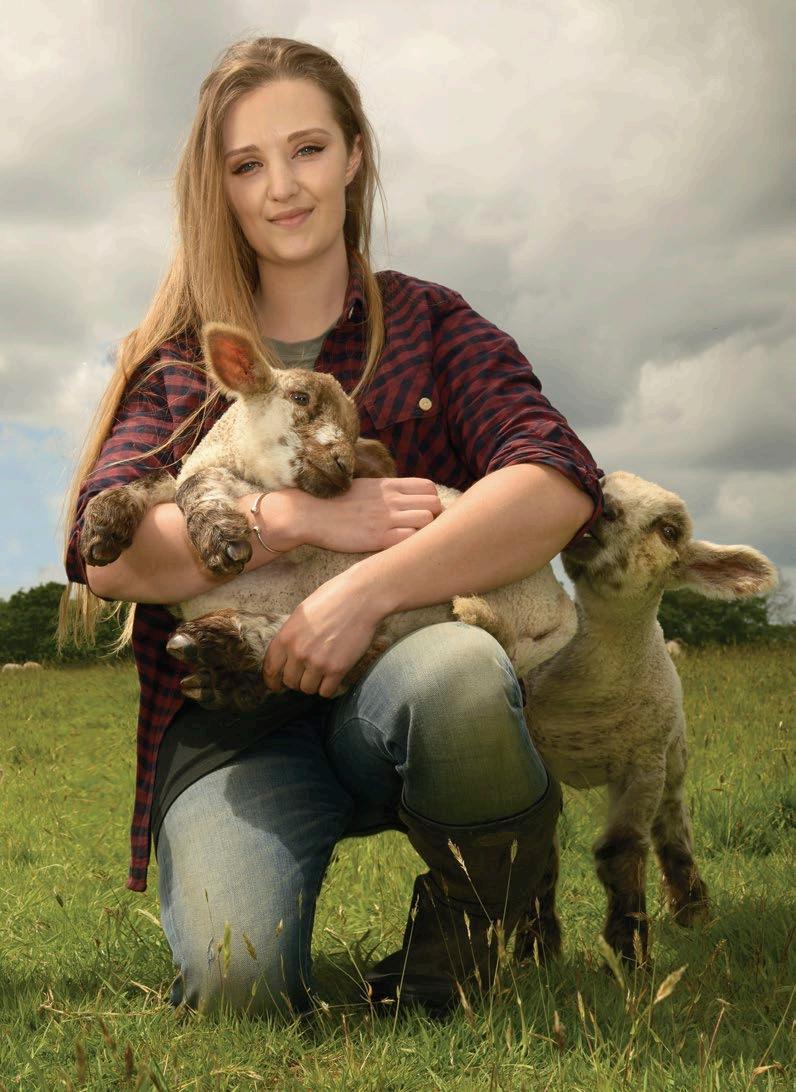
INSPIRE
“I
t happene D in f ebruary last year,” says Jodi Fenwick. “I was driving down a hill when the steering column sheered through as I was turning a corner. I had no steering—and I’ve no idea how I managed to miss all the oncoming traffic—but I ended up spinning and flipping downhill, landing upright facing back up the hill.”
It was an experience from which Jodi was lucky to escape alive. “The rescue services thought they would have to cut me and my brother out of the wreckage, but I was able to walk away from it. But all the discs in my back shifted and squashed my sciatic nerve. I still can’t feel parts of my leg or foot, after two operations. My brother had a couple of fractures, along with cuts and bruising.”
The nightmarish episode couldn’t have come at a worse moment, just as Jodi—better known as “The Solo Shepherdess”, after the popular blog she writes on her outsider’s take on raising sheep and building up her own flock—was gearing up for the lambing season. As a measure of her determination, she still carried out lambing on two local farms whose combined flock size amounted to 3,000 ewes. “I like to keep my word,” she states.
As for her own flock, she’s built it up to 60 this year, with young lambs already fattening ahead for Christmas markets. Did she need any help?
“Oh, no,” says the 27-year-old. “I worked within a team on those other farms, but I always do mine myself.”
Doing for oneself seems to be central to Jodi’s modus operandi. We’re talking in the sitting room of the farmhouse near Battle where she lives with mother Lynne and brother Gary. From the window, the land slopes away on a fine prospect of the High Weald of Sussex at its rustic, undulating, tree-filled prettiest. Of more immediate importance to Jodi, it also overlooks the green pastures— which enable her to keep an eye on her precious animals.
These are headed by Ramsey, a Ryeland ram with a normally teddybearish face who currently looks “a bit like ET because he’s just been shorn”, and ewes from an assortment of other breeds—all looking proud of themselves with their recently born lambs at foot.
It has, admits Jodi, taking a rare moment to settle in a comfy armchair, been a hectic lambing season. “I barely got to sleep during it, to be honest. I was up every three or four hours, checking the animals. Whereas larger operations can afford to pay for night lambers to come in, when you have a more modest-sized flock you tend to take it all on yourself. But,
78 | 09•2016 T H e So L o S H e PH erde SS
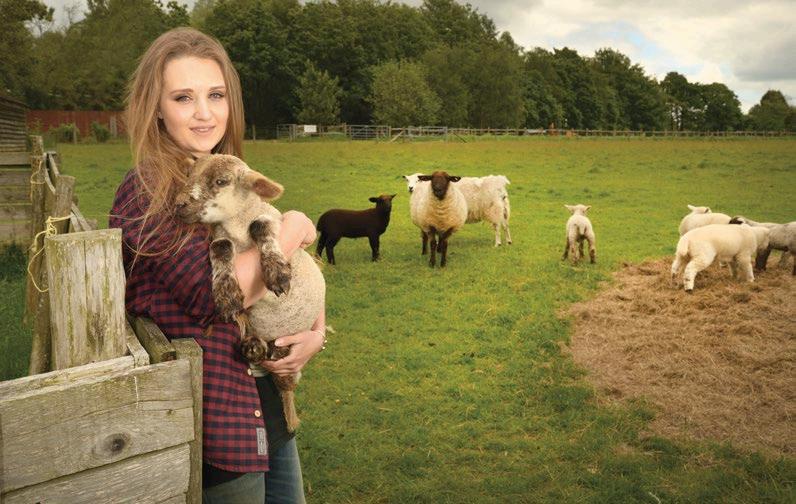
frankly, I don’t mind. I’m quite an independent person and I don’t like to ask for help.”
Fortunately, only one lamb was lost. Jodi tube-fed him for several nights with the dam’s colostrum (the ewe’s first milk, which is vital for boosting the lamb’s immune system), as he was too weak to feed from the ewe himself, before he finally died. “I call him Ivan the Great—a big name for a little lamb.”
breaking into farming seems to have been a mix of serendipity and willpower. It all began in Surrey, where she was born. Riding ponies from early childhood, her livery stables were on a farm where the elderly farmer was finding it difficult to maintain his large sheep flock.

Jodi began helping him—casually at first, pointing out when she’d noticed a particular sheep was lame, then gradually taking on more duties and assisting at lambing.
Equine interests remained primary for a while, but by the time they had moved to Battle, the sheep were taking a hold.
“Mum bought this farm because she had a long-term, as yet unfulfilled, plan of getting into holiday lets using
79 09•2016 |
ALL P H o T ogr AP HY: J AM e S e cker SL e Y
Jodi gives all her sheep individual care
shepherd’s huts,” says Jodi, explaining how they arrived at the 30-acre unit seven years ago. “She keeps pigs and runs a day-care nursery here, which looks after kids between three months and five years old. And I wanted space to have my own sheep, and for them to be right by me, so I was around if there was a problem.”
Having started with pedigree Gotlands, a relatively unusual breed in this country, further experience shepherding on local farms has given her a more market-focused approach. Her current flock includes Suffolks —an immensely handsome sheep that was once the leading commercial breed in the country—plus Texel, Jacob and Black Welsh Mountain crosses. Some ewe lambs brought in
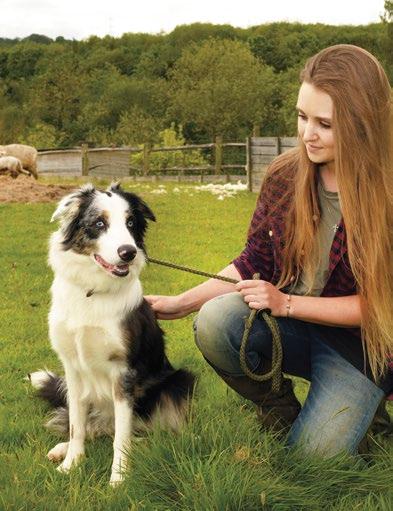
from a farm in nearby Robertsbridge have had to be bottle-fed—much to the delight of children attending the day nursery.
Jodi’s enthusiasm for her sheep is infectious. “It’s a complete passion,” she says. “It’s never really going to be a job that’s easy, but it’s always going to be one that’s worthwhile. I couldn’t imagine myself doing anything else, really. I absolutely adore it.”
She has an idea to run courses for smallholders or for “people who’d like to keep sheep but have no idea how to start”. There’s no doubt she’d be terrific at this, not least because she radiates the joy to be had in farming and working outdoors.
i t’s fair to say that—in an industry in which females are still few and those from a non-farming background even fewer—Jodi is something of a mold-breaker. There’s a streak of the unconventional about her. Even the foxes behave differently in Jodi’s fields.
“They go and sunbathe in them with the sheep,” she laughs. “I’ve never been able to get a picture because, obviously, they’re off as soon as they realise you’re near, but I’ve often seen a line of four or five sunning themselves out there, with the lambs running around them. It’s quite bizarre.”
She started her blog with the similar idea of inspiring would-be self-starters. It got picked up by an
T H e So L o S H e PH erde SS
Jodi’s dog Bess plays a vital role in rounding up the flock
The 27-year-old on her smallholding in Battle. “I couldn’t imagine myself doing anything else”

online magazine, The Indie Farmer—a platform for a new breed of producers seeking to explore ways to farm—and now she does a monthly post called “The Country Chronicle”.
“That’s not just about sheep, but our kitchen garden, the pigs, and anything I’m building or fixing at the time, from feed troughs to sheds.”
Jodi’s fulfilment is found through the animals and the land. But the workforce on farms is ageing, and she agrees that more could be done to encourage first-time farmers. “A lot of younger people have started to show an interest in agriculture, but they do a course and then struggle to get an
opening. The industry is dominated by older people who are set in their ways, and more could be done to help first-timers get tenancies or be given help to purchase or let land.”
She also can relate to the uneasy feeling of going to markets as “a complete newbie where everyone seems to know everyone else, and you’re standing thinking, I can’t speak because I don’t know anyone, and it feels really uncomfortable”. In the end though, she says, “It’s like any industry—you have to have the right conversation skills and personality, the right attitude.”
She attributes her own can-do
81 R EA d ER ’ S dI g EST 09•2016 |
mentality to her late grandfather. “He was great at finding ways to do things. That’s my mentality. If it doesn’t work one way, try a couple of other ways. Keep trying until it works.”
Farming can be rather solitary, so does she worry about isolation? “No, I absolutely don’t,” she replies emphatically. “I’m not someone who needs company. I’m comfortable with my own. Given the point I’m at with my business, I don’t have time to socialise.
“I have contacts through farming, but my main support is from my mother and brother. And I’m not a girly girl. I’ll wear make-up, but my dress sense isn’t girly. I’d like to start my own Solo Shepherdess clothing range though. In country stores all the women’s stuff is pink, turquoise, tight-fitting or low-cut. I know other girls in the industry who are like me. We just want casual workwear in gentle, subdued colours, especially around stock where the brightness can be unsettling.”

she knows she’s unlikely to achieve riches doing what she’s doing, and jokes that the hours are more five-to-nine, than nine-to-five. But she has no intention of letting her flock get too large in search of profits.
“Maybe 200 to 300 sheep at most,” she reckons. “I don’t want to get to the point where I couldn’t look after them and give them all the individual care. I know other farmers that don’t check their sheep for a couple of days, and that’s something I can’t envisage myself doing. Whatever challenges I face, I don’t think I’d ever be able to give this up. Every day I smile just looking at my sheep.”
There are lots of gloomy predictions about the future of British farming, claiming it’s squeezed by imports and the power of the multiples. But while it continues to attract people like Jodi, with her death-defying determination, it’s still clinging onto its soul.
To read more about Jodi and her sheep, visit thesoloshepherdess.co.uk
did you know that Britons lose 84 million socks a month? Well, one laundrette has come up with a brilliant and heartwarming solution to the age-old odd-sock conundrum.
SoURCE: THEPoKE.Co.UK
| 09•2016 82 T H e So L o S H e PH erde SS
WE l C om E H om E
A


Virtues Off Season of the
travel & adventure
© Westend61 GmbH/Al A my s tock P H oto

Just after sunset in Oia, Santorini’s best-known village
A mother and daughter find the joy of travel minus the crowds
85
by e linor a llcott Griffith
o. Stop. Go. Stop. the travel SiGnalS in my head
were mixed, conflicting. “Are you sure you want to head to Greece this November with Kathleen?” asked my husband. “The weather could be unpleasant.”
A take-charge kind of person, my daughter quickly googled “November weather for Athens”.
“Temperatures will be slightly warmer than in New York City,” she said. “And rainfall for the month—in the two-inch range—doesn’t sound like a monsoon. As for rough winter seas, let’s hop on planes instead. We’ll have endless hot-from-the-oven, spinachy spanakopita, imagine that, and be fine.”
“You must go,” said my friend Larry, who raved about having spent Thanksgiving on Santorini. “Sunsets are among the most gorgeous in the world and the island is the legendary location of the lost city of Atlantis. It’s a paradise. All you’ll need is a warm hooded jacket.”
With his encouraging words, I booked our flights to Athens and included two Greek islands: Santorini (how could we resist such a place?) and Crete. Renowned for beaches and ancient ruins that my parents had delighted in seeing years earlier, such as the Palace of Knossos, Crete was the furthest south of all Greek islands.
Sunshine and a brisk Saturday afternoon welcomed us to Eleftherios Venizelos Airport in Athens. During the next days Kathleen and I ate the crispiest spanakopita imaginable; we ranked our favourite feta, tomato,
cucumber and olive-studded salads, and tried unknown-to-us foods. No annoying lines of tourists either, as we saw sights on the Athens “A” list: from the Acropolis and Archeological Museum to the ancient Panathenaic Stadium. We poked around the ruins at Delphi, home of the Oracle and once considered the centre of the universe.
And then came Tuesday. Heavy rain kept us dashing between stores and museums. The next day’s flight to Santorini was yo-yoed by wind gusts up to 40 miles an hour, our stomachs bumping up and down, our view obscured by squalls. “I’m truly sorry,” the flight attendant said. “The storm has stalled.”
The cliff-top town of Fira, usually a much-photographed tourist destination, was chilly, rainy, foggy... empty. Only a darker grey fuzziness differentiated land from sea. With
VIR t U es o F t H e o FF se A son P H otos, clock WI se FR om to P le F t: © G A b RI el A Ins URA tel U /Al A my s tock P H oto; © mAR o k o URI /Pol ARI s; © yA nn I s k ontos/Pol ARI s; © V I cto RIA W I lk I nson bR o W nless/Getty Im AG es
86 | 09•2016
G



 Clockwise from top left: ruins at Delphi; taverna at Kamari beach, Santorini; artifact at the National Archeaological Museum, Athens; the Parthenon, an ancient temple on the Acropolis in Athens
Clockwise from top left: ruins at Delphi; taverna at Kamari beach, Santorini; artifact at the National Archeaological Museum, Athens; the Parthenon, an ancient temple on the Acropolis in Athens
rain streaking our faces, Kathleen and I edged along a cliff to our hotel and checked in for a three-night stay, the only guests. As we stepped down steep stairs towards our bungalow dug into the cliff itself, a gust of wind suddenly pushed us towards what we’d been told was a sheer 500-foot drop into the Mediterranean, still obscured by fog.
Unnerved, unsettled, we fled into the cave-like rooms. We tried to read. We heated up tea with honey to settle our queasy stomachs. Read a little more. “This isn’t how I want to spend my holiday,” said Kathleen, who hadn’t smiled in hours. “Maybe Crete isn’t experiencing the same storm. Can we fly out later today?”

Her question mirrored my own thoughts, and yet I felt trapped by commitments. We couldn’t leave. We’d just arrived. Payments for the hotel and rental car would be lost, and costly last-minute plane reservations needed. And I could hear myself telling my husband, who’d thought the trip ill-advised, that we’d never seen Santorini’s famous views.
“Let’s not decide right now,” I suggested to Kathleen, trying to put pep into my voice. “At least let’s give the place a day.”
“OK,” said Kathleen. “But,” she continued pragmatically, “maybe we needn’t stay the whole time.”
We Were a Silly SiGht—our colourful plumage of clothing consisting of long-sleeved shirts under hooded sweatshirts, and puffy vests, pashminas and gloves. Thus warmly adorned, we sped off on adventures:
...Up a rocky hill to ruins at ancient Thira. With the rain easing, we drove to the southern side of the island and then climbed up rugged roads. To reach the old hill-topper village with the remains of a few houses and the agora, or market, we had to inch cautiously over a thin slippery land bridge with an unsettling 1,200-foot precipice on one side and a jagged slope on the other.
“Can you believe this?” asked Kathleen, exhilarated by crossing
VIR t U es o F t H e o FF se A son P H oto co UR tesy o F t H e AU t H o R
88 | 09•2016

safely. “We’re retracing steps Greeks made thousands of years earlier, perhaps daily since their farms were on flat land along the sea far below.”
...To another cliff-side village, Oia. Despite more showers, we stayed another day and ventured to Oia. A friendly woman corralled us on a deserted street and in excellent English asked, “Would you like to attend my church’s feast day?” The tiny Greek Orthodox church she attended was the size of a very large kitchen. Several dozen black-clad women were singing and talking in one corner, more people than we’d seen in the entire town. They pressed glasses of sweet red mavro wine into
our wet hands. Showers lifting, we stepped back outside and marvelled at the town’s precarious perch on the cliff’s edge.
“The earthquake of 1956 caused immense damage,” said the woman, pointing to abandoned cliff cave houses, known as skafta. “It was the Aegean’s largest quake of the 20th century. Homes crumbled, some tumbled into the sea, and yet our lives somehow went on.”
...To VERY leisurely meals. No reservations needed. At a restaurant named Poseidon, on our third night (yes, we stayed the full time and did see Fira’s iconic blue-domed church), we waited and waited, and waited
© J A n Wlod AR czyk/Al A my s tock P H oto
89 09•2016 |
Famous view of a church in the cliff-top town of Fira. Santorini has more than 250 churches; (opposite) the author and her daughter in Santorini
some more, for dinner: artichokestuffed squid and grilled grouper with a tomato-olive sauce. “The chef is now back,” our waiter explained sheepishly. “Your dinner will be out shortly. The chef was busy studying something beautiful.”
Seeing our puzzled look, the waiter then confessed, “He went out for a smoke, saw a beautiful girl and began to flirt until the owner started to yell and, and, and...”
Suddenly, Kathleen laughed. Instead of reprimanding the waiter impatiently, she leaned back and smiled, and out came a loud, happy sound. A joyful laugh.
An attitude adjustment into grace, I realised, had been happening since our arrival. My daughter had shifted into a “going-with-the-flow” mindset. She was the one leading me. As she said later: “You know, Mum, you can’t live a positive life with a negative, critical mind. I’m learning that Greek people have their own wonderful sense of time and priorities.” The tables had truly turned.
Several day S later on Crete, sunny and warm as anticipated, we continued to relish the off-season pleasures of uncrowded beaches, museums and historical sites. In driving merely half an hour out of Irakleio, for instance, we visited the Palace of Knossos—in essence, time travelling back to around 1700 BC, or so it felt because we were virtually the only ones there. Well, and the ticket-taker and four iridescent, bluegreen plumaged peacocks.
“Give me a pinch,” said Kathleen. We were now facing a charging bull, actually on an ancient fresco. “I can’t believe we’re in the same palace once visited by Grandma June and Grandpa John,” she said. “I’m so glad we came to Greece in the off-season.”
Grace surrounds us. The challenge is to let go of anxieties and worries, the tendency to complain, that can hover nearby like a Greek fog. A sunny disposition—your sunny disposition, wherever you are—can let grace shine and clear the air for everyone. That and a hooded jacket!
Impress acquaintances with these facts about big ben.
“big ben” isn’t actually the tower. it’s the bell inside it. the tower itself is leaning, much like the tower of Pisa. british pennies are used to adjust the time in the clock.
source: factslides.coM
VIR t U es o F t H e o FF se A son
| 09•2016 90 AdAP ted FR om The VirT ues of Cooking P assin G the ti M e
 By C at H y ada MS
By C at H y ada MS
My Great Escape: Italian Lakes

Cernobbio lines the shore of Lake Como; (right) Bellagio is known as the “Pearl of the Lake”
Bridget Yates from Leicestershire sails around Lake Como, with added prosecco…

Cathy has danced in Rio, been microlighting in South Africa and hiked the mountains of Oman

“The nex T glass of prosecco to touch my lips will be in Italy!” I announced confidently, two days before our departure to Lake Como. Unfortunately, the promise was broken that evening when we began our packing, “to put us in the mood”.
My partner John and I love the Italian Lakes, and we try to go every year. Last summer we chose Lake Como. We flew out at the end of August, landing into the blue skies of Bergamo outside Milan. We were staying at the elegant Regina Olga Hotel in Cernobbio, right on the shore of Lake Como. It was the perfect location: in a pretty little town and an easy, interesting walk along the lake to the larger town of Como a mile away.
The highlight of all of our trips to this lovely part of Europe (apart from the prosecco!) are the ferries. We can happily spend a day criss-crossing the lakes, getting on and off as we please, exploring the many towns and villages that hug the shores and, of course, enjoying the local cuisine.
One particular gem is Bellagio, set on a promontory of Lake Como, whose steep, cobbled streets are filled with flowers.
travel & adventure
| 09•2016 92 © Fedor Se L ivanov/ S hutter S to C k
Just across the lake, the beautiful Villa del Balbianello is another must-see: built in the 18th century, it’s home to an unusual collection of furniture and elaborate gardens.
However, for me, it’s all about the prosecco. It is the quintessential taste of the Italian Lakes—sparkling, light, filled with sunshine and happiness.
■ Water and BuBBleS
Flights to Milan start from £31.99 one-way with easyJet (easyjet.com).
Rooms at the Regina Olga Hotel start from £142 per night (+39 031 510171, hotelreginaolga.it).

Postcard from ... Guernsey

san DWI che D Be TW een Britain and France, Guernsey is one of the warmest places in the British Isles— with summer weather lasting well into September. Which is fortunate, as the Guernsey Walking Festival launches this month with more than 50 guided walks, ranging in length and ability. Led by accredited guides, the walks explore Guernsey’s rugged coastlines and its lush interior. Examples include “Herm Above & Beyond”, discovering Guernsey’s tiny neighbour Herm, and “Coast to Coast”—an all-day ramble through the rural and historic island.
■ WalK On By September 3–18, from £7 per person (guernseyguidedtours.com).
tell us about your favourite holiday (send a photo too) and if we include it on this page we’ll pay you £50. Go to readersdigest.co.uk/contact-us
09•2016 | 93
Want tO Hear FROM YOU! © aL exandre r otenber G / S hutter S to C k
We
Things To Do This Month

Moscow in two Minutes
■ See: TolsT oY ’s MoscoW Channel War and Peace on a trip around the key locations shown in this year’s BBC adaption of Leo Tolstoy’s famous novel. Sites include the Kremlin and Tolstoy’s Museum. Travelsphere offers an eight-day trip from £1,499pp (01858 897 273, travelsphere.co.uk).
■ vISIt: reD o cToBer A renovated chocolate factory on the banks of the Moscow River has become the trendiest spot in the Russian capital. Expect upscale restaurants, art galleries and boutique shops—plus spectacular views across the river.
■ StrOll: g orkY park
The city’s central green lung is a great place to see ordinary Moscow life unfold— whether strolling its green boulevards or skating on the ice rink during colder months (visitrussia.org.uk).
Long/short: artistic ho L idays
l ong: ayers rock resort
This resort, which overlooks Ayers Rock in central Australia, is putting on a six-month artist-in-residence programme showcasing indigenous work. This month Raymond Walters Japanangka, known for his vivid paintings, is working in-house (+61 02 8296 8010, ayersrockresort.com.au).

s horT : s omerset open studios
Artists in more than 200 venues throw open their doors to show the public the inspiration and creative processes behind their work. Until October 2 (somersetartworks.org.uk).

travel app
Of tHe MOntH
Yahoo radar, free, ios. This pulls all your travel information (flights, hotels, rental cars) from your email and displays it on one clean, clear interface. There’s also a handy virtual assistant.

| 09•2016 94 trave L & adventure
© www.voya G e S C om.au
Insurance Costs Rise For Older Holidaymakers
A report by Which? has revealed that older holidaymakers face sharp increases in the cost of travel insurance, despite the fact that they claim less frequently.
Which? obtained quotations that illustrated that healthy travellers aged 75 pay more than twice as much for an annual worldwide policy as someone aged 65.
Quotations for a healthy traveller aged 85 are five times more costly than those aged 65.
Data from the Association of British Insurers (ABI) illustrates that while 7.2% of 61- to 65-year-olds claim on their travel insurance, the figures fall to 5.6% for those aged 76 to 80.
increased travel by older people to destinations outside the European Union resulted in much higher claim costs, as there’s no access to free medical care through the European Health Insurance Card.
The United States of America is the most expensive country in which to fall ill—with medical bills averaging more than £4,700. The global average for medical claims on travel cover is approximately £1,300.

A study by the British Insurance Brokers’ Association identified
Very large claims—in excess of £75,000—are becoming more frequent. Few people can afford to find such amounts, so it’s therefore essential to have the correct travel-insurance protection in place before you travel.
To discuss your travel-insurance requirements—and to obtain a competitive quotation—call us today on 020 8069 3102. One of our expert advisers will help provide the travel-insurance policy that matches your requirements.
PARTNERSHIP PROMOTION
Save The
An Austrian couple are taking on the loggers to save Europe’s last great forest wilderness
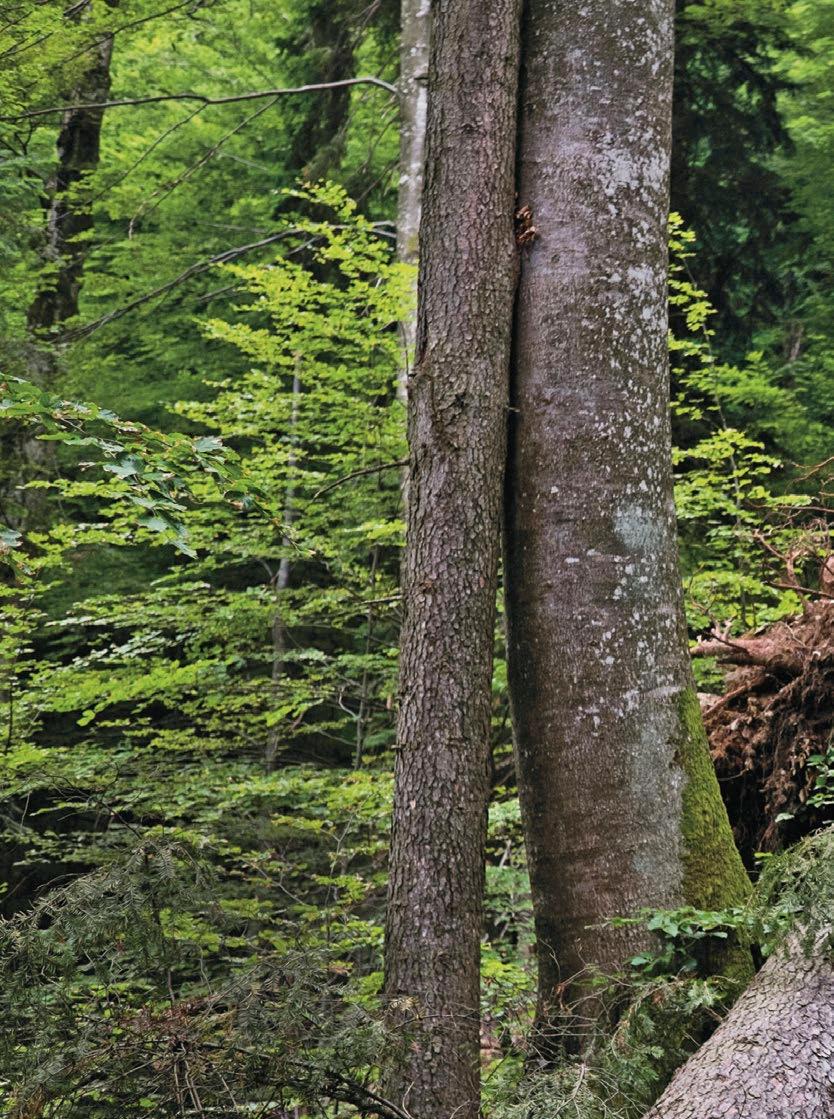 BY ALLAN HALL
BY DAVIN ELLICSON
BY ALLAN HALL
BY DAVIN ELLICSON
PHOTOGRAPHED
96 TRAVEL & ADVENTURE
 Forest
Christoph and Barbara Promberger in their beloved Carpathian forest
Forest
Christoph and Barbara Promberger in their beloved Carpathian forest
CHRISTOPH AND BARBARA PROMBERGER were hiking through the virgin forest one summer morning in 2007. The sun was shining and birds were singing high in the trees. Occasionally the undergrowth rustled with the movement of unseen animals.
They were deep in Romania’s Piatra Craiului National Park, part of the Carpathian Mountains, a range that forms a 932-mile-long arc that stretches through seven countries. It’s home to some of Europe’s rarest large mammals: the wolf, the lynx and the brown bear, as well as many other species.
The Carpathians hold Europe’s largest remaining areas of virgin forest outside of Russia, yet all was not well in this vast haven of biodiversity.
Walking with the couple, the park’s director, Horatiu Hanganu, sombrely described the destruction taking place around them. Vast tracts of woodland, unchanged for thousands of years, were vanishing, eaten up by the biting teeth of power saws as unauthorised and illegal logging cut swathes through the forest.
And then, on the other side of the mountain, they came across a scene of carnage. Illegal loggers had ripped through the forest, destroying trees and flora along with the nutritious soil. Few birds were singing because there were no trees for them to nest in; there were no animals because the undergrowth protecting them had been torn away, leaving a scarred, broken landscape.
“I felt sick to my stomach that someone could do this to such a beautiful place,” says German-born Christoph, 50. “It broke my heart,” adds his Austrian wife Barbara, 41. “If you care for nature and for the conservation of our environment, you cannot tolerate such scenes.” But that day in the forest proved to be a life-changing moment for the couple, propelling them on a mission to save this mountain wilderness for future generations.

CHRISTOPH AND BARBARA had first come to Romania in 1993, as biologists on a project to study the large carnivores that thrive in the
SAVE THE FOREST MAP BY ACUTE GRAPHICS
98 | 09•2016

Carpathians. They’d married five years later in Austria after falling in love during their nocturnal charting of the region’s mammals.
The Prombergers’ study of the region’s carnivores ended in 2003, but they were in no mood to return home. “We loved Romania so much that we wanted to stay on,” says Christoph. So they founded Equus Silvania, an equestrian centre and guesthouse 15 miles from the national park they’d grown to love.
“We thought of a place that would incorporate Barbara’s love of horse riding with the possibility for watching wildlife, together with a self-sustaining farm. It’s an equestrian centre, but is so much more than just that.”
Here, a three-hour drive north
of Bucharest, they brought up two daughters while also tending to 35 horses. They kept pigs, chicken, geese and ducks, and grew a large variety of fruits and vegetables.
But the lack of management of the surrounding countryside was an everpresent concern to them.
In 2004 the Romanian authorities began to hand back land seized by the state to the families who once owned it. In a poor region, it was an invitation for locals to give their land over to the men with the chainsaws. The loggers paid well for the spruce, fir and beech wood, which ends up in sawmills for the production of chipboard, laminate, flooring, furniture and pellets for stoves.
“Most of the local owners had little economic empathy for the land and
© SHUTTERSTOCK/INNA TES
99 09•2016 |
A hillside in the Carpathian forest lies denuded following logging

were willing to sell it, or its resources, to the highest bidder,” says Christoph. For the forests, and the animals living in them, the change was catastrophic.
CHRISTOPH AND BARBARA felt helpless, but then came a stroke of luck. In 2007, a guest called Hedi Wyss visited their retreat. They talked with Hedi about the destruction to the forest and their heartfelt desire to halt further devastation.
“Hedi had already founded her own conservation organisation and when we discussed what we wanted to do—save the national park on our doorstep—she was enthusiastic.”
“Hedi told me, ‘My brother is the man to stop this!’ ” says Christoph.
Hedi wasn’t exaggerating. Her brother just happens to be a Swiss biotechnics multi-billionaire. The second richest man in Switzerland, 79-year-old Hansjoerg Wyss is listed by Forbes magazine as having a fortune of more than £4.5bn.
Hedi arranged a meeting. Hansjoerg visited Equus Silvania and the four got to work.
“Our plan revolved around saving the Piatra Craiului National Park, which was being ravaged,” says Christoph. “But Hansjoerg was already dreaming of bigger things.
“He said he’d help on two conditions. The first was that our original plan for the park on our doorstep was too small. He wanted it ultimately to encompass much more land.”
Hansjoerg’s second condition was that he didn’t want to be the sole benefactor. “We had to attract more people committed to this idea,” says Christoph. “He felt that such a big project should not rest on the shoulders of one person.
“We thought about it and decided we’d go for it!” Just before Christmas 2009, Foundation Conservation Carpathia was born.
The quest was daunting. Facing them were gangster-like loggers, indifferent local police and corrupt bureaucrats who would rather take kickbacks than take on the criminals.
© PHOTOGRAPH
BY
DAVIN ELLICSON
100 | 09•2016
The Prombergers study a map showing the progress of their conservation project
“We have had some pretty scary moments,” says Christoph. “We’ve had car tyres slashed, and one of the forest rangers had his life threatened by a man who illegally grazed his cattle on land that was off-limits. It’s a struggle to change the perceptions of people to their environment.”
Barbara and Christoph networked tirelessly, tapping into all of their conservation friends and contacts.
“One contact led to another, and another, and another, and we found that people were willing to help us in our vision,” says Christoph. Help came from far and wide—one significant donor was a Danish philanthropist based in Hong Kong. They’ve never looked back.
OVER THE PAST SIX YEARS,
of wood for a house somewhere halfway around the world?”
Today, a board of ten people oversees the Foundation, which has some 35 employees, including 20 rangers who patrol the vast tracts of the forests to make sure no illegal loggers are tempted back. Christoph and Barbara are in day-to-day charge as co-CEOs.
We agreed that talking is all very well, but if you want to change something, action is needed
Christoph and Barbara have raised over £40m and chased the loggers out of vast tracts of the wilderness.
In the valleys cut by chainsaws the Prombergers and their helpers have planted new beech, elm, ash and fir trees to replace those levelled by the loggers for furniture stores.
“Can you imagine,” Christoph says, “these magnificent trees being felled and the land being scarred, the plants and the wildlife dying out, all because of some heating pellets and sheets
“We get funding from the Life Programme of the European Commission and also from the Norwegian government, as well as donations,” says Barbara.
Among other things, the money helps to pay for the regeneration of areas where trees have been clear-cut. Such areas often suffer major soil erosion because of the way logs are dragged down the mountains, tearing up the earth.
Christoph and Barbara are thinking big. The ultimate goal, inspired by Hansjoerg Wyss’ words, is to create a “European Yellowstone”.
That’s some challenge, as Irish environmentalist Lenny Antonelli observes: “The Plombergers’ project might just be the most ambitious and exciting conservation project in Europe…and if they succeed, this has the potential to become one of the largest wild areas in Europe.”
READER’S DIGEST
101 09•2016 |
They’ve set their sights on a protected area of 200,000 hectares in the Fagaras Mountains near their home in the foothills.
“This isn’t just about stopping illegal logging, but all industrialscale logging, where the profits don’t go into the local community but into countries far away,” Christoph says.
“We want to see small craft logging industries that would spin off into carpentry workshops. Sustainable agriculture. People benefitting from activities that don’t harm the environment. It’s an unashamedly holistic approach.”
strain on wildlife. There’s still corruption, there’s still a mafia at work. But things are changing.”
“We now have 28,300 hectares of hunting-free zone, 16,015 hectares of forest land saved for full protection and we have planted over 466,000 trees.
We’ve chased the loggers out of the park. Now we must chase them from the Fagaras range
Experts say the clearing by loggers amounts to three football-field-sized chunks of Carpathian forest every single day. Although attitudes among local people are slowly changing, the Prombergers say corruption and apathy are a continuing obstacle.
“Those who have got rich from illegal logging like to build gaudy weekend homes in the forest without planning permission. This puts more
The Foundation’s ultimate goal is one day to donate everything back to the people of Romania. But that will happen only when the state is in a better shape to manage it. Fortunately, there are some signs of change. A year ago, Romania’s parliament approved a new forestry code to curb illegal logging and make it easier for smallholders to make money legally from their forest land. The country’s anti-corruption agency is also investigating some officials in the state forest administration.
Meanwhile, the Plombergers’ work goes on. Christoph is resolute, saying, “We’re committed to this project, along with all our backers, to make this the most important, and biggest, natural park in Europe.”
THESE BOOTS ARE MADE FOR WALKING
It’s estimated that the average human takes 183,755,600 steps in a lifetime.
SOURCE: VERYWELL.COM
SAVE THE FOREST
102 | 09•2016


A charming and informative foray into the history and architecture of the picturesque market towns of middle England. Architectural historian Alec Clifton-Taylor OBE presents a potted history and architectural study of six small English towns of great character. First broadcast on BBC Two in 1978, the programmes now serve as a fascinating historical snapshot of the enduring character of each locale. 3hrs.

166445 Six English Towns
DVD is out on 12/09/2016. RRP: £19.99 Selling Price: £14.99
HOW TO ORDER
(Please quote RDP042 when ordering)
Online: shop.readersdigest.co.uk
Phone: 0844 332 8080 (8am-8pm Mon-Fri, 9am-5pm Sat-Sun)
By Post: Reader’s Digest, FREEPOST, RTHR-LLRY-ZHYS, Ringwood, BH24 1HD (Cheques should be payable to Reader’s Digest.
Please remember to quote RDP042 and include your full name and address.
READER OFFER
Keep It In The Family

If you want to make sure your hard-earned wealth benefits your children and grandchildren, you need to take action now
It’s a basic human desire to see the fruits of our labour pass down to future generations—it’s our legacy. But if you don’t take action and plan for the future, there are some significant threats to your wealth.
Every family is different and there’s no “one size fits all” solution, so taking advice from a specialist is a crucial starting point.
PARTNERSHIP PROMOTION
THREE THREATS TO YOUR FAMILY’S WEALTH
CARE FEES
With the care fees funding cap now “abandoned” in the words of our former care minister, it’s clear that action must be taken to plan and protect against the high costs of care where possible. If you require care and have assets exceeding £23,250—often including the value of your home—you will likely have to fund that care yourself, possibly from the sale of your home. With the average annual care home bill pushing towards £50,000, it’s easy to see how an inheritance intended to benefit your loved ones can erode very quickly.
LOSS OF CAPACITY
We rarely receive warning of accidents or illnesses, the likelihood of which increases as life progresses. You may assume that the authority to manage your financial affairs and make decisions about your medical care and health automatically passes to your next of kin. It doesn’t. Without a Lasting Power of Attorney in place, your next of kin are required to obtain an order from the Court before they can manage your affairs—which is a long, complex, expensive and intrusive process.
SIDEWAYS DISINHERITANCE
If you leave all your assets to your spouse or partner and they meet someone else after your death, everything you have worked hard for could pass to someone you didn’t intend to leave it to. If you leave an inheritance to your children and they suffer a marital breakdown, that inheritance could form part of a divorce settlement.

Take the first step to protecting your family and wealth by requesting your free information pack. Call Reader’s Digest Legal on 0800 031 9516 and quote reference “RDL15”.
LEGAL
Reader’s Digest Legal is a service provided by the Collective Legal Solutions Group.
Make The Most Of Cashback
It may seem counterintuitive, but spending money can help you to make money—as long as you’re clued-up
B Y A N d Y W
EBB

Andy Webb is a money expert at the Money Advice Service. Visit money adviceservice. org.uk for details

GettinG paid to shop seems like a stranGe idea, but that’s exactly what cashback is. Whether it’s through your credit card or via an app on your mobile, it’s possible to claw back a little of your spending each time you shop.
It’s not free money—cashback is offered as an enticement to make you spend, and possibly on things you might not have bought in the first place. Plus, you might be able to find what you want cheaper without cashback if you shop around. But if you’re planning on buying something anyway and know the pros and cons of each method, it’s a fantastic way to boost your income. There are four key ways to earn cashback:
Credit cards
You need to apply for a specialist cashback credit card, but if accepted you’ll be able to get between 0.5% and 3% in cashback on each full pound you spend. This is normally paid annually, or as points you can exchange for a reward.
Each credit card works in a different way. Some give the same rate on everything you buy, while others only give you money back on specific purchases, such as petrol. Many also come with a fee, so it’s worth working out if you’ll be able to earn enough cashback to cover this. The important thing to remember is they’re only a good idea if you can pay the balance off in full every month—any interest charged will negate any benefits of cashback.
MONEY
| 09•2016 106

Bank accounts
Some current accounts will give you cashback, again between 1% and 3%, on your bills. They do come with a fee, so check how much you’re likely to earn in cashback to see if it’s worthwhile. Other current accounts also offer bonus cashback specific to chosen shops and restaurants. You normally need to activate these offers.
Cashback websites
Websites such as Topcashback and Quidco act as the middle man between you and online retailers, and in return they give you a cut of the commission. This could be a couple of per cent when buying some clothes, to hundreds of pounds for opening a new mobile-phone contract.
The main issue here is that the money isn’t guaranteed, so don’t buy something through cashback sites based solely on the extra cash you’ll get. Again, it’s worth shopping around to check there aren’t better deals available without cashback.
Utility switching
Switching your energy, broadband, phone and TV services can often save you hundreds of pounds—and you can sometimes make a little extra by looking for cashback.
When you use a comparison site, it’s most important to make sure you are choosing a provider that works for your needs, but an extra £30 could be a useful nudge to help chose between two similarly priced options.
09•2016 | 107
Tasha T uvango/shu TT ers T ock
©
Can The Over-50s Get On The Housing Ladder?
It’s not just the so-called “Generation Rent” who can’t afford to buy. A third of those aged 50 and above are renters, according to recent research.
Divorce is cited as one reason for the increasing numbers—the figure was 25% just five years ago—with one in five renters over 50 single and trying to get back on the housing ladder a second time. And as with young people, increasing house prices can make this difficult to achieve.
BuYiNg A hOME WhEN
YOu’rE OvEr 50
One challenge older home buyers might find is getting a mortgage in their later years. Historically, mortgage lenders haven’t been keen to offer mortgages that would be paid back after retirement—the risk being if you’re not earning, how will you pay off the mortgage?
Most lenders have a maximum age of between 65 and 75 by which the mortgage must be paid off. But

there are a small number of banks that will lend as long as it can be paid off by the age of 80—while some specialist mortgage brokers might be able to find even later cut-offs.
However, these extensions don’t mean you’ll be able to get one of these mortgages. As well as various terms and conditions, the same lending rules apply whatever your age, so it’s worth reading up on the affordability checks that were introduced in 2014.
You’ll need proof of a retirement income. That could be your pension, or, now many of us are working for far longer than the traditional cut-off, wages should help demonstrate you can manage the repayments. But the lenders will also look at how you spend your money and how you’d cope if you couldn’t work.
| 09•2016 108
money
Start Your Advent Of Savings Now
It might be the tail end of summer, but if you leave your Christmas planning until December, you could be faced with a surprising and nasty hit to your finances.
Last year’s Money Advice Service Christmas survey found the average festive spend was £500. That might seem a bit much, but once you’ve added in presents, food and drink, decorations and travelling to visit the family, it can quickly add up.
Start planning and you’ll be able to avoid borrowing on credit cards or dipping into your overdraft to make sure you can afford the Christmas you want.
First, set a budget on how much you think you’ll spend. List out all the people you want to buy for, then work out how much money you’ve saved up and how much you think you can put away before December. This should help you work out what you can afford as gifts.
Take advantage of special offers and sales to stock up on presents throughout the autumn, rather than leaving it all to the busy Christmas period—it’ll be easier to keep track of your spending and ensure you’re sticking to budget.
If things look a little tight, or you’re just worried about the spending getting away from you, you could look for ways to cut back. Though children always enjoy getting a present, adult friends and family might be happy to set a limit of £10 or £15 per person—or even club together to buy joint presents. And don’t forget to have enough money put aside for the Christmas extras such as travel, parties and food and drink.

FOR MORE, GO TO rEAdErSdigEST.CO.uK/MONEY © kurhan/shu TT ers T ock / p I m p I c/shu TT ers T ock rEA d E r’ S d ig EST 09•2016 | 109

The Shocking Truth Driven To Distraction
SATELLITE NAVIGATION, DAB RADIOS, MOBILE PHONES, BLUETOOTH CONNECTIONS, CLIMATE CONTROLS... the list goes on. These are all things found in modern cars that can cause “driver distraction”. Driver distraction is any non-essential task that may reduce the quality of your driving, making you less observant, less careful—and increasing the likelihood of an accident. The Royal Society for the Prevention of Accidents (RoSPA) recently quoted a US study which revealed that driver distraction was responsible for 78% of road crashes.
If you're unfortunate enough to be injured in a road traffic accident by a distracted driver, you should first seek any medical attention required as soon as possible. However, there are also a number of things you should remember that will assist you in making a subsequent successful claim.
1. Do not admit liability. A full evaluation of the circumstances may reveal that the accident could have been avoided if the third party had acted differently.
2. Take down all of the driver’s details. As well as their name and contact number, ask them for their insurance details and make a note of their vehicle registration number.
3. Gather evidence at the scene. Take pictures of the accident scene and damage to each of the vehicles. Make a note of the road and position of the vehicles before the accident and the time of the day.
4. Take down witness information. If anyone witnessed the accident, ask them for their name, number and a correspondence address.
PARTNERSHIP PROMOTION
When making a claim, be prepared to answer questions such as:
• Weather conditions on the day
• Speed of travel
• Visibility
• Details of what happened and where
• The third party's details
• Witness details (if any)
• Police attendance (if any)

Name: Peter Accident Type: Road accident Awarded: £4,500
An experienced injury solicitor will offer you the best advice and help you claim compensation. Reader's Digest is pleased to introduce Accident Advice Helpline, a specialist personal injury law firm recommended by Dame Esther Rantzen. Their expert injury solicitors will be able to provide you the best possible help and advice. As a reader of Reader's Digest, you can call 0800 740 8991 now for a quick and confidential FREE CLAIM ASSESSMENT.

I got in touch with Accident Advice Helpline after a serious motor accident. I was off work for ten weeks. I spoke directly to a representative from Accident Advice Helpline and they were ever so helpful.
It took a lot of the stress out of the situation. They were very professional in everything they did, which made it easier for me. I received over £4,500.

As recommended by Esther Rantzen
Call Accident Advice Helpline now on 0800 740 8991 for a FREE confidential claim assessment.
Our lines are open 24 hours a day, 365 days a year.
Call 0800 740 8991 or visit readersdigestaah.co.uk

LEGAL
This service is offered and operated by, and your resulting contract will be with, Accident Advice Helpline; a company wholly independent of Reader’s Digest and Vivat Direct Limited. Accident Advice Helpline is a trading style of Slater Gordon Solutions Legal Limited. Slater Gordon Solutions Legal Limited is a company registered in England & Wales with registration number 07931918, VAT 142 8192 16, registered office Dempster Building, Atlantic Way, Brunswick Business Park, Liverpool, L3 4UU and is an approved Alternative Business Structure authorised and regulated by the Solicitors Regulation Authority. Authorised and regulated by the Financial Conduct Authority.
Easy-to-prepare meals and accompanying drinks
Chorizo And Prawn Paella
BY RACHEL WALKER

Rachel Walker is a food writer for numerous national publications. Visit rachel-walker.co.uk for more details
DID YOU KNOW that the Spanish have a specific word for the slightly crunchy, caramelised rice that forms on the bottom and round the edge of a paella pan? The scoarrat is the rice equivalent of the crispy chicken skin, or pork crackling—so even though it seems counterintuitive to let rice stick to the pan, it’s the key to an authentic paella. Simply refrain from stirring, kick back and watch the rice cook from a distance—preferably with a chilled sherry in hand.
Serves 6
• 2tbsps olive oil
• 1 onion, diced
• 1 red pepper, sliced
• 225g chorizo, chopped
• 1tsp smoked paprika
• 2 tomatoes, diced
• 100ml sherry or dry white wine
• 400g Bomba paella rice
• 800ml chicken stock
• Pinch of saffron (optional)
• 150g raw king prawns
• Handful of parsley, roughly chopped
• 1 lemon
1. Heat the oil in a paella pan or a wide-bottomed pan, and then cook the onion, red pepper and chorizo on a low heat for 8 minutes.
2. Once the onion and red pepper have softened, and the chorizo is giving off a deep red oil, then stir in the smoked
FOOD & DRINK | 09•2016 112
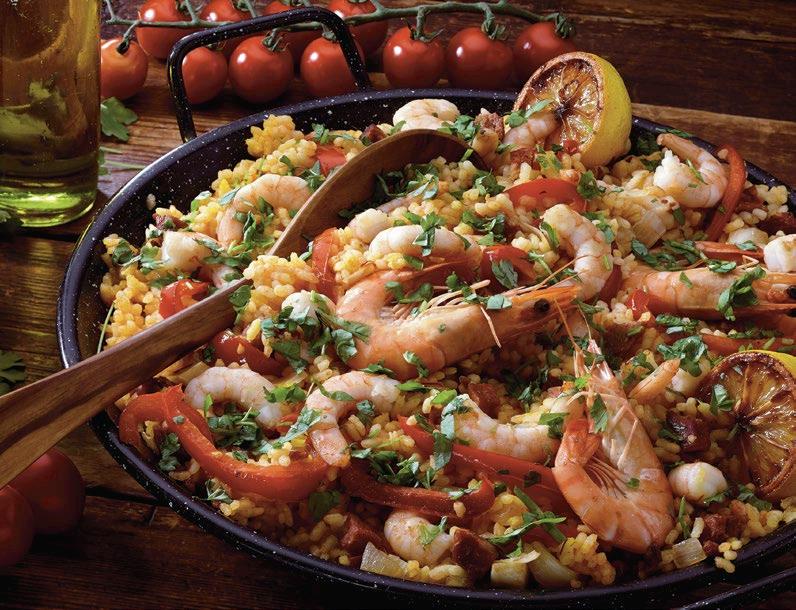
paprika, add the tomatoes and sherry, and bring the sauce to a simmer.
3. Add the paella rice to the pan and stir so all the grains are coated in the sauce and they’re starting to absorb all the delicious flavours.
4. Meanwhile, bring the stock to a boil. If using saffron, add it to the stock at this point. Add 600ml of the stock to the rice, and leave it to cook at a rolling simmer—uncovered and without stirring—for 12 minutes.
5. Add the remaining stock and then arrange the prawns in a circle on top of the rice. Let the rice cook for another 5 minutes and then taste a
couple of grains to check it’s cooked through—though a little bit of an aldente “bite” is a good thing.
6. Take the pan off the heat and cover it with tin foil for the final 5 minutes. The trapped steam and heat will cook the prawns and improve the texture of the rice.
7. Garnish with chunks of lemon, scatter over a handful of chopped parsley and serve.
09•2016 | | 113 PHOTOGRAPHY BY TIM & ZOË HILL
readersdigest.co.uk/ food-drink
Discover more delicious recipes at
Sherry Redefined
SHERRY COMES with a set of associations: great aunts, cut crystal, Sunday lunch. This seems unfair. Whiskey, gin and rum aren’t saddled with this kind of reputation—they effortlessly regenerate their image each generation, always renewing their appeal.
It’s a misunderstood drink, mainly because British sherry drinking has centred around sweet cream sherry. Its heady raisin notes divide opinion, as fruit cake does. But the Spanish tradition of sipping a chilled Fino or Manzanilla with tapas couldn’t be further from the British tradition of cream sherry in cut glass.
Fino is light, crisp and dry—the best starting point for novices. Next up is Manzanilla and Amontillado, which are a little darker and more

fortified—but both are still delicious chilled and sipped straight. Oloroso is further down the list, its walnut colour and nutty, dried-fruit notes making it an elegant alternative to port with a cheese board. Pedro Ximénez rounds off the selection. It’s a completely different beast to Fino—thick and dark, sweet and pruney.
So why not dabble with a new tipple? The sherry category is ripe for exploration—and its lack of street credibility means there’s great value to be had.
TOP SHERRY PICKS
■ The Society’s Fino (15%), £6.25, The Wine Society
■ La Gitana Manzanilla (15%), £11.99/£47.94 for a half-case, Majestic
■ Lustau East India Solera Rich Oloroso Sherry (20%), £10.49, Waitrose
■ M Signature Pedro Ximénez (17%), £6, Morrisons




FOOD AND DRINK | 09•2016 114
Pudding of the Month

Warm Figs With Honey
This is such an easy dish to make—and the creativity comes with the way you serve the figs. Start with plump, ripe figs and you can’t go wrong. A dollop of crème fraîche, greek yogurt or scoop of ice cream is delicious. Get more experimental by topping each fig with a halfteaspoon of ricotta or soft goat’s cheese before grilling. Garnish with fresh thyme, crushed walnuts or a drizzle of Pedro Ximénez sherry.
Serves 4
• 8 figs
• 2tbsps honey
Optional extras: thyme, walnuts, sherry
1. Cut the figs in half, lengthways.
2. Arrange them on a tray and drizzle the honey over them.
3. Cook under a grill for five minutes, until hot and soft.

Basque: Spanish Recipes from San Sebastián and Beyond, Amazon, £17. Chef José Pizarro’s latest tome— full of recipes to impress.
BARGAIN

Waitrose Cooks’ smoked paprika, Ocado, £1.99. Shopbought paprika differs greatly, but this range really delivers.
BLOW OUT

16-person enamelled paella pan, Brindisa, £32.95. Invest in a good paella pan to get that scoarrat crispy rice.
READER’S DIGEST 09•2016 | | 115
BOOK
FOR MORE, GO TO READERSDIGEST.CO.UK/FOOD-DRINK © VIENNETTA/SHUTTERSTOCK
BY LYNDA CLARK

Lynda Clark is a homes, property and interiors expert, and is editor of First Time Buyer magazine
Shades Of Grey
PREDICTED TO BE THE NEW MAGNOLIA, grey is a easy and restful shade, and there are several ways to work with it. An effective look is to layer three different tones of grey next to each other or, for a bolder approach, inject a pop of colour and use grey as the backdrop to the room.
If your room is north-facing, grey will appear to take on a bluer hue and can feel a little cold, so add yellow, gold, pink or red to the space. But if it’s south-facing, it’ll create a much warmer and brighter atmosphere.
Dahlia sofa, £1,285; Dahlia armchair, £855; Bramble bedside table, £250; vintage rose cushion, £35; lavender cushion, £35; knitted throw, £90; antique trinket box, £50; set of three Mercury bud vases, £20; Mercury candle sticks, small, £30; large, £40; set of three votive candles, £20; Catherine vase, £45; Mercury trinket tray, £15; Elizabeth lace vase, £50; Ellen vase, £50.
■ All available at House of Fraser (houseoffraser.co.uk)
Get The Look
Stylish accessories to enhance your decor.
■ Camille cabinet, £499, Marks & Spencer (marksandspencer.com).
■ Lace hurricane lamp, £20, Debenhams (debenhams.com).
■ Landscape cushion, £7, George at Asda (george.com).
■ Bardon armchair, £499, Very (very.co.uk).




| 09•2016 116 HOME & GARDEN


HANGING OUT
Short on space but want a kitchen garden? Try growing lettuce, mint and basil in these unusual hanging vertical planters, which can be screwed to a fence or wall. With room for up to 12 plants, the top two pockets feature drainage holes that will water the plants below, while the bottom pocket is sealed to stop compost falling through.

■ Burgon & Ball Verti planter, £9.95 for a pack of 2, John Lewis (johnlewis.com).
SHINING BRIGHT!
As the days draw in, it’s time to get some outdoor lighting

Copper is bangon-trend right now. Sabrebeam outdoor LED light, £50 (johnlewis.com).

Shine with this polished brass nautical-inspired light, £54.99 (dowsing andreynolds.com).

Try this sleek, industrialstyle garden-path light, £90 (cuckooland.com).
09•2016 | 117
FOR MORE, GO TO READERSDIGEST.CO.UK/HOME-GARDEN
From subtle home CCTV to augmented reality, where will tech take us next?
Real Life, Uploaded
By olly mann

Olly is a technology expert, radio presenter and podcaster
Canary, £159
There are seemingly zillions of home security systems, all of which broadcast live pictures to an app: I’ve previously doffed my cap to Google’s Nest cam, which we use as a baby monitor (and cat monitor when we’re on holiday because…well, why not?). But they all look like cameras, and so their presence can feel slightly sinister. Canary, however, looks like a home entertainment speaker. Its cylindrical design discreetly suits most rooms in your house—but it’s not so camouflaged that it seems you’re actually trying to spy on people.

apple app of the month: moonpig, free Moonpig has been online since 2000, but only recently have I tried out their app. A friend posted my six-monthold son a cool science toy, so I thought it would be sweet


to send her a thank-you card emblazoned with a photo of him playing with it. It was astonishingly straightforward to upload a photo from my camera roll to the app, select a font, type in my text and pay via PayPal. Seamless.
Technology | 09•2016 118
philipS amBilight tV 7101, 49-inCh £799, 55-inCh £999 TVs have become steadily cheaper, and features that were once considered premium—multiple speakers, 4K resolution, built-in apps for Netflix and the like—are now ubiquitous. So if you’re a mainstream manufacturer like Philips, how do you make your reasonably priced, Ultra-HD, smart TV stand out? Apparently, you put “edge lighting” on it. What’s that? Some LED lighting strips embedded in the back of the set, which project coloured light on to the wall, to mirror the colours featured on screen. When you’re watching Batman, it’s oddly cool. When you’re watching Newsnight, it’s just odd.
tefal aCtifry Smart, £299

Tefal have shifted more than a million of their Actifry “healthy fryers”, which can cook up a family portion of chips using just one spoon of oil by circulating hot air. The new model inevitably offers smartphone connection—but, for understandable safety reasons, doesn’t offer the smart feature you’d really want: the ability to cook a meal remotely. Instead, it syncs with Tefal’s recipe app, featuring dozens of dishes. The fryer automatically tells the app to move on to the next stage of the recipe as you complete each step; the app instructs the fryer to adjust the fan speed, and so on. A bit gimmicky, but it still makes some damn good chips.


android app of the month: pokemon go, free This augmented reality game is more than just an app, it’s the schoolyard trend of 2016: this year’s hula-hoop, loom bands and Beanie Babies all rolled into one. By accessing your smartphone’s camera, the app reveals animated Pokemon (“pocket monsters”) hiding in the real world around you, whom you have to hunt down—a great way to encourage kids out of the house.

09•2016 | 119
Smartphones Have More To Offer Than Just Calls And Messages
FOR THOSE WHO ARE YET TO BE CONVINCED of the benefits of owning a smartphone, and who may see them as little more than toys that can make phone calls…here's an interesting tale that may convince you of their usefulness.
"I've just returned from a holiday in the south of Italy, where my Doro Liberto® 820 Mini smartphone was more useful than a Swiss Army knife," says Dick Lumsden.

"We arrived late at night (because of an air traffic control strike, naturally) into an unfamiliar city, and were taken away from the airport to a car-hire pick-up location in the middle of nowhere.
"With no idea of where we were, and consequently no idea how to find our hotel, I turned to my smartphone for help. Using the Google Maps app, I pinpointed where I was, and then searched the address of our hotel. Instantly the phone turned into a sat nav and directed us with spoken instruction to find our hotel with the minimum of fuss.


Translating through the camera lens
"The next day, driving to our holiday villa, I discovered a hitherto unknown quirk of Italian motoring. When you pull into a space in a pay-and-display car park, you have to enter part of your car’s registration number into the machine before it will print your ticket.
"Discovering this would have been difficult had I not turned again to my smartphone. Using an app called
PARTNERSHIP PROMOTION

Google Translate, my phone’s camera took an image of the parking instructions and instantly translated it on screen.
"And as if these two functions alone weren’t enough to convince unbelievers of the worth of a smartphone, when we arrived at our destination in deepest Puglia and discovered we had no wi-fi, I was able to convert my Doro into a mobile 'hotspot' using the internal settings, and allowed the whole family to browse the internet and say 'Hi' to friends back home.
"Modern smartphones are about more than making calls and sending messages. They are multi-purpose tools to make our lives easier—and I for one would not be without my Doro."


Buy a new Doro Liberto® 820 Mini smartphone today, for the special price of £150, which includes an Anywhere SIM card connection and £40 of credit, allowing you to roam the UK with signal from O2, EE and Vodafone. You can roam across Europe with no extra charges.
Simply go to readersdigest.co.uk/mobilephones or call 03454 133 953 and quote “Reader’s Digest offer”. SPECIAL READER’S DIGEST OFFER!
By Geor G ina yates

Georgina is a fashion and beauty editor for numerous travel titles and a blogger at withgeorgia.com
The Perfect Fit
When you knoW you’re out for the DAy and won’t be able to pop home to refresh, it’s very hard to resist squeezing your entire make-up kit into your handbag. Travel-sized products aren’t made for everyday use and run out alarmingly swiftly.
Luckily, there’s been a trend for full-sized products that fit perfectly in your purse and perform a number of tasks, and the brand Bobbi Brown is leading the way. Their Instant Confidence Stick (£26) is a clear formula that’s smooth like serum and firm like a paste, and can be used throughout the day to retouch over wrinkles and absorb excess oil. Follow this with the moisturerich foundation stick (£29.50), which is available in 24 shades. Lastly, dab cheeks and lips with multi-purpose creamy Pot Of Rouge and you’re ready to go!
■ All available at bobbibrown.co.uk
Co-worker
■ The main ingredient in Dr PAWPAW Original Clear Balm (£6.95, drpawpaw. com) is fermented paw paw, a fruit known for its medicinal properties. Keep some in your desk draw and use it as lip balm and to soothe areas of dry skin.

Fresh-FaCed



■ When you’re glued to the computer screen, your skin can start to feel a little stagnated after a few hours. Spritz Murad’s Hydrating Toner (£25, murad.co.uk) over your face, neck and chest for an instant moisturising boost.

| 09•2016 122
Fashion & B eauty
work it

■ When the air conditioning is a little too chilling, wrap up and stay both stylish and warm in a Merino wool pashmina (£72, thewoolcompany).
For Him For Her

■ Too hot for a coat still? Try throwing a lambs-wool cardigan over your shoulders for a body temperature that’s just right (£39.50, marksandspencer).
■ Summer-to-autumn workwear can be tough to get right, but this tailored shirt-dress is fit for both seasons (£199, wearcecily.com).

■ Fancy yourself the office trendsetter? Stay cool in this cotton collarless shirt (£69, jigsaw-online.com).


■ If you want to wear glamorous footwear to work, a chunky heel will be much more steady and comfortable than a stiletto (£139, hobbs. co.uk).

■ Moshulu’s shoes fit like gloves—and these orange-lined boots make a subtle statement too (£69, moshulu.co.uk).
09•2016 | | 123
It’s a month of ripping reads rather than literary nuance, with new offerings from two big players
September Fiction
BY JAMES WALTON

James writes and presents the BBC Radio
4 literary quiz
The Write Stuff
Mount!
by Jilly Cooper (Bantam, £20)
Fans of subtlety should, of course, look elsewhere. In Cooper’s latest blockbuster—again set in the horse-racing world—it’s certainly not difficult to tell what she thinks of any of the characters. (“A gold-digger and an absolute bitch, Anthea had never given Dora enough pocket money.”) There’s also a Chinese man who refers to “Loyal Ascot” and even a baddie called Sheikh Baddi.
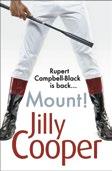
The book sees the return of several Cooper favourites, including Rupert Campbell-Black: these days approaching 60 and only intermittently caddish, but still irresistible to all human females (especially Jilly Cooper). The new characters, meanwhile, are a familiar mix of old soaks, young studs and women who are generally either “nymphos” or “poppets”.
In other words, at 79, Cooper shows no signs of losing her touch, or of disappointing her readers. (Even those fans of subtlety might be disappointed only by how much they enjoy the whole mad confection.) Oh yes, and Mount! also contains the ultimate Cooper sentence—when Roddy Northfield recalls how “his fiancée, now wife, Enid, had been seduced by Rupert
NAME THE AUTHOR
(Answer on p128)
Can you guess the writer from these clues (and, of course, the fewer you need the better)?
1. Her maiden name was Stephen.
2. She belonged to a group that “lived in squares, painted in circles and loved in triangles”.
3. Nicole Kidman once played her.
BOOKS | 09•2016 124
at a hunt ball in a blue and green William Morris-curtained four-poster”.

Conclave by
Robert Harris (Hutchinson, £20)
Like Harris’s acclaimed Cicero trilogy, his new novel concerns a power struggle at the heart of Rome. This time, though, the action takes place in the near future rather than classical times, because Conclave begins with the death of a Francis-like pope and then takes us behind the scenes at the election of his successor.
Harris has clearly done his homework, and the book bristles with fascinating information about how the process works. He’s good too (and by no means lazily cynical) on the curious combination of godliness and human politicking involved. The picture of the Church that emerges is wholly persuasive, with the liberals and conservatives slugging it out from what they consider the best of motives.
Add to that a well-paced series of twists and a fine central character in the shape of the conclave’s harassed organiser Cardinal Lomeli and, for most of the time, the result looks like being another high-class Harris thriller. Until, that is, the final and biggest twist of all—which, for my money, is pitched somewhere between the entirely unconvincing and the hopelessly silly.
PAPERBACKS
■ Hubris by Alistair Horne (W&N, £12.99) The muchadmired historian examines six battles that changed the 20th century, and how they were won and lost.
■ How to Find Love in a Bookshop by Veronica Henry (Orion, £7.99) Winningly warm-hearted novel with an appealing heroine, who fights to save the Cotswolds bookshop she inherited from her father.
■ Sentenced to Life by Clive James (PIcador, £9.99)
Poignant, unflinching collection of poems in which James looks back on his life after being diagnosed with terminal cancer.
■ Missing, Presumed by Susie Steiner (The Borough Press, £7.99) Superb crime thriller introducing DS Manon Bradshaw, who looks set to join the ranks of grumpy cop greats.
■ David Bowie: Album by Album by Paulo Hewitt (Carlton, £19.99)

A very thoughtful consideration of Bowie’s output by the veteran rock critic.
09•2016 | 125
Despite the daily headlines and alarmist news stories, the future isn’t all doom and gloom—and here’s why RD’S RECOMMENDED READ
Looking On The Bright Side

ACCORDING TO A 2015 POLL, 71 per cent of Britons think the world is getting worse. But, as this heartening book by Johan Norberg (right) conclusively proves, they’re wrong. By any objective measure of well-being, this is the best time in human history to be alive. Norberg’s ten reasons, each with its own chapter, range from food to literacy, freedom to clean water. In every case, he has the scrupulously researched facts to back up his central idea that the good old days are now; and that only people either ignorant of the past, or who choose to romanticise it, could possibly think otherwise. Thanks to

Progress: Ten Reasons to Look Forward to the Future by Johan Norberg is published by Oneworld at £16.99
advances that began in 18th-century Europe, and gradually spread through the rest of the world, the things that made most human lives nasty, brutish and short have been—or are being— triumphantly overcome.
So why don’t we realise it? The problem seems to be that when homo sapiens first emerged, worry and fear were useful tools for survival, and so became part of our DNA. Yet modern doom-mongers almost invariably turn out be wrong— mainly because they reckon without human ingenuity.
In 1968, Paul Ehrlich’s best-selling The Human Bomb warned that “in the 1970s, hundreds of millions of
| 09•2016 126 BOOKS
people are going to starve to death”. Instead, new ways were found to produce food on a scale never before imagined.
Throughout the book, Norberg mixes the long-term improvements with reminders of how much better life has become for millions of people in the past few decades alone— especially in Asia and, increasingly, sub-Saharan Africa. Here he presents the long view:
Consider a ten-year-old girl 200 years ago. Wherever she had been born, she could not have expected to live longer than around 30 years. She would have had five to seven siblings, and she would already have seen at least one or two of them die. The chance that her mother would survive childbirth was smaller than the chance that the present generation will meet their grandparents.
She would have been brought up under conditions we consider unbearable. Her family would not have had access to clean water or a toilet. Chances are that they did not even have a latrine; they would have used a ditch or gone behind a tree. Her surroundings would have been littered with garbage and faeces, contaminating water sources and devastating lives. Her parents would live in constant fear that she would be taken away by tuberculosis, cholera, smallpox, measles—or starvation.
NOW AND THEN: MORE FACTS FROM PROGRESS
Life expectancy at birth has increased more than twice as much in the last century as it did the previous 200,000 years.
150 years ago, it took 25 men all day to harvest and thresh a ton of grain. With a modern combine harvester, one person can do it in six minutes.
In 1653, John Evelyn made a note in his diary that he was going to start experimenting with “an annual hair wash”.
Nearly a third of the global population have gained access to proper sanitation in the last 25 years—2.1 billion people.
In Kenya, life expectancy has increased by more than a year every year for the past decade. In other words, the average person can expect to have more years of life left than they did ten years ago.
In Sweden (one of the few countries where the figures are available), around 1,000 mothers died per 100,000 childbirths in 1800. 100 years later, it was around 500. Now, it’s fewer than ten.
09•2016 | 127 READER’S DIGEST
‘‘
This little girl would have been stunted, skinny and short, since she lived in a world of chronic undernourishment and recurring famine, where people did not get the energy to grow and function properly. This would also have halted her brain’s proper development. She would not receive any schooling,
She lived in a brutal world, where the risk of a violent death was almost three times higher than today. Britain had 300 capital offences on the books, and she would still see corpses displayed on gibbets…
The same ten-year-old girl living today is more likely to reach retirement age than her forebears
She lived in a brutal world, where the risk of violent death was almost three times higher than today
and would never learn to read or write. She would certainly have been put to work at an early age, but would have been blocked from almost all occupations, and would be considered the property of her father, until he married her away, at which point ownership would pass to her husband. If he beat her or raped her, there was no law banning it. She would not be able to organise politically to change this, since she would not have the right to vote or stand for election, no matter where she lived.

AND THE NAME OF THE AUTHOR IS…
Virginia Woolf (of the Bloomsbury group, described that way by Dorothy Parker). Kidman won an Oscar for playing her in 2002’s The Hours
were to live to their fifth birthday. Even if she lives in one of the world’s poorest countries, she has better access to nutrition than a girl in the richest countries 200 years ago. The risk that she will lead a life of extreme poverty has declined from 90 per cent to less than ten per cent. She goes to school just like almost everyone in her generation, and illiteracy will be eradicated during her lifetime. Her parents probably support her so that she won’t have to drop out to work. Now she has a good chance of living in a democracy, where women have individual rights and protections. She faces a lower risk of experiencing war than any other generation in human history. Her risk of dying from a natural disaster is 95 per cent smaller than it would have been 100 years ago, and she will not even hear of a major famine anywhere.
© CATWALKER/SHUTTERSTOCK | 09•2016 128
BOOKS
’’
Books
that change D M y l I fe

actor robert Bathurst reprises his role as David Marsden in Cold Feet this autumn, as the new series of the hugely popular Itv comedy-drama returns to our screens—13 years after the last episode.
A Scattering
By Christopher reid
Christopher Reid’s wife died in 2005 and this wonderful collection of poetry is his tribute to her.
I read it at a time when there was someone close to me who was very ill—I had all the anxieties and confusion that Reid expresses so beautifully, and it gave me great comfort at a difficult time. The poems are the best expression of grief and a celebration of life; we must enjoy our time while we can.
The Great Terror
By roBert Conquest

remarkable study in how power is created and sustained—in Stalin’s case by purges and man-made famine, which resulted in the deaths of some 15 million Russians in the 1930s.
George & Sam
By Charlotte Moore


I studied law before becoming an actor, and I’ve always been intrigued by how the law can be used to support tyranny. This book reveals how Stalin was able to carry out unspeakable atrocities and then have the courts justify his actions. It’s a
I was brought up during a time when if anyone was bit different they were considered odd. Nowadays, I’m glad to say we have become much more accepting of people’s differences and that’s down to books like this—Charlotte Moore’s account of family life with her two autistic sons. Charlotte’s wonderfully accepting and loving outlook is humbling and inspiring. We all need to understand that the uncontrollable forces—which make some people unable to see things through the prism of what we might regard as “normal”— aren’t to be feared, but embraced. As told to Caroline Hutton
09•2016 | 129
© Steve Ullathorne
FOR MORE, GO TO readersdiGest.Co.uK/BooKs
You Couldn’t Make It Up
Win £50 for your true, funny stories! Go to readersdigest. co.uk/contact-us or facebook.com/readersdigestuk
mY HUsBanD Brad was watching a programme about Hugh Hefner, who had three live-in girlfriends. He watched enviously and thought aloud, “That could be me, you know. I’ve got a dressing gown!”
amIe YeTTOn, Cambridgeshire
a WORK COLLeaGUe
had just celebrated his 50th birthday at the weekend and I was aware he wasn’t very happy about reaching this milestone in his life.

“Wrong court, M’Lud”
He came into the office on the Monday looking glum. When I asked him why he was down, he retorted, “Put it this way—I had a party on Saturday night and my neighbours didn’t even realise.”
maXIne COOPeR, Newcastle
mY LOVeLY DaUGHTeR Sophie is 34 and my gorgeous grandson Tim is seven. Recently Tim was very upset because his goldfish Pinkie has died. “Next time just buy him another
goldfish and say Pinkie woke up,” I said after listening to Sophie’s story.
I saw Sophie’s face change. “Mum, how could you?” she said. “That’s how Goldie lived to be 15!”
OLGa aRnOLD, by email
HaVInG JUsT ReJOIneD his fishing club, my husband dragged his old fishing bag out of the cupboard and started pulling out its paraphernalia. On opening a pouch, he exclaimed, “Oh, it’s all my flies!”
Without looking I asked if they were
CARTOON: S T eve J ON e S | 09•2016 130 FUn & Games
OK, seeing as they’d been packed away for so long. He gave me a very odd look and said, “Of course not. They’re dead!”
GeORGIna DOWns, West Sussex
WHen mY sOn was about six years old we had a sweet-tempered Old English Sheepdog who would take any amount of pestering in her stride. But on one occasion, I’d asked my son several times to please give her a rest and leave her in peace—requests he’d completely ignored.
Eventually, in desperation, I told him in no uncertain terms to leave her alone, stop pestering her and forget that we even had a dog. Several minutes later the following conversation took place:
Son: “Mum?”
Me: “What now?”
Son: “I wish we had a dog!”
FRanCes HUnT, Hertfordshire
WHen I FeLT something scratching my finger, I realised that one of the claws on my ring had broken and the diamond was missing. Hours of searching proved useless and I’d given up hope of finding it.
However, it turned up quite unexpectedly. My daughter, who much to my dismay always leaves a pile of shoes at the bottom of the stairs, felt she had a stone in her shoe while walking to the bus stop. Amazingly, it was my diamond sticking in her foot!
Of course, she was keen to point out that if she’d moved her shoes when asked, we might never have found the diamond.
CHRIsTIne mILLeR, Lancashire
OUR FIVe-YeaR-OLD daughter Mary (second name Eva) is just learning to read and is very proud of herself. She delightedly announced to me the other day, “Mummy, my second name is an actual word!”
When I asked what she meant, she said, “You know, Mummy, you’re eva upstairs or you’re downstairs.”
KIRsTY COTTReLL, Cheshire
manY YeaRs aGO when my children were young, we were at the beach one day when my younger daughter rushed from the shallows to announce that she’d seen a jellyfish in the water.
“Are you sure it was a jellyfish?” we asked.
“Yes, it was,” my little angel rather indignantly replied. “I know it was because it had testicles”
DenIse BROaDFOOT, by email
mY 14-YeaR-OLD sOn decided to wash his best sweatshirt. After a few minutes of staring at the washing machine dials, he asked me, “What setting should I use?”
“Well, it depends,” I told him. “What does it say on your shirt?”
He looked at it and said, “NIKE.”
LOReTTa JenKIns, Clwyd
Rea D e R ’s D IG es T 09•2016 | 131


We’re delighted to say our shop just keeps getting better - with a wide range of new products being added every single week.


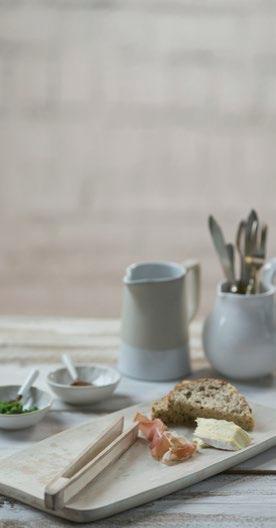

What’s more as a valued subscriber you are eligble for 10% OFF all of your purchases - simply quote RDSUB10 when ordering.
Don’t miss our OUTLET SALE which will see huge reductions on many lines, PLUS you can still claim your extra 10% off these already discounted lines.
shop.readersdigest.co.uk
IT PAYS TO INCREASE YOUR
Word Power
Does your lexicon need a lift? Try these terms guaranteed to impress even the most well-versed wordsmiths—from the vocabulary-building book Talk Like a Genius by Ed Kozak. Stumped? Check the next page for answers.
BY EMILY COX & HENRY RATHVON
1. capitulate v—A: provide funding. B: stop resisting. C: state formally.
2. unequivocal adj—A: cool under pressure. B: untamed or out of control. C: leaving no doubt.
3. cavalier adj—A: nonchalant or marked by disdainful dismissal. B: dome-shaped. C: undefeated or worthy of praise.
4. leery adj—A: untrusting. B: odd. C: off balance.
5. levity n—A: taxation. B: merriment. C: departure.
6. penchant n—A: informal recital. B: strong liking. C: very deep or ruminative thought.
7. bifurcate v—A: tell lies. B: flash like lightning. C: divide into parts.
8. craven adj—A: chiselled. B: needy or famished. C: cowardly.
9. coterie n—A: exclusive group. B: takeover. C: birdcage.
10. stalwart adj—A: loyal. B: lefthanded. C: disguising weakness.
11. travesty n—A: wardrobe. B: long journey on foot. C: absurd imitation.
12. hedonism n—A: espionage. B: sun worship. C: pursuit of pleasure.
13. obviate v—A: watch over. B: prevent or render unnecessary. C: leave unfinished.
14. excoriate v—A: hollow out. B: criticise harshly. C: sketch in detail.
15. penurious adj—A: given to fits of rage. B: wordy. C: poor.
09•2016 | 133
Answers
1. capitulate—[B] stop resisting. “Only when I wrapped the pill in bacon did my dog finally capitulate.”
2. unequivocal—[C] leaving no doubt. “The umpire raised his finger in an unequivocal fashion.”
3. cavalier—[A] nonchalant or marked by disdainful dismissal. “Our driver had a shockingly cavalier attitude about the steep mountain road ahead.”
4. leery—[A] untrusting. “Initially, Eve was a touch leery of the apple.”
5. levity—[B] merriment. “Our family thankfully found moments of levity during the memorial.”
6. penchant—[B] strong liking. “Thomas was warned repeatedly about his penchant for daydreaming in meetings.”
7. bifurcate—[C] divide into parts. “If anything, Jeremy Corbyn has certainly managed to bifurcate the nation.”
8. craven—[C] cowardly. “She took a markedly craven position against the weak crime bill.”
9. coterie—[A] exclusive group.
“Claire’s coterie consisted entirely of fellow Mozart enthusiasts and accomplished violinists.”
10. stalwart—[A] loyal. “Throughout the election campaign, William has repeatedly shown stalwart support.”
11. travesty—[C] absurd imitation. “Her lawyer demanded an appeal, calling the jury’s decision a travesty of justice.”
12. hedonism—[C] pursuit of pleasure. “In Shakespeare’s Henry IV, young Prince Hal mistakes hedonism for heroism.”
13. obviate—[B] prevent or render unnecessary. “Gloria’s doctor hoped that physical therapy would obviate the need for more surgery.”
WORD OF THE DAY*
VARGLE:
14. excoriate—[B] criticise harshly. “The coach was excoriated by the media for his tactics and substitutions during the game’s tense final minutes.”
to work in an untidy way.
Alternative suggestions:
“To gargle with vinegar.”
“When you can giggle in a variety of ways.”
“What a German citizen does—said in broken English as he waves his flag from side to side.”
15. penurious—[C] poor. “Paul and Carla entered the casino flush and left it rather penurious.”
VOCABULARY RATINGS
9 & below: prodigy
10–12: mental giant
13–15: genius
WORD POWER | 09•2016 134
*POST YOUR DEFINITIONS EVERY DAY AT FACEBOOK.COM/READERSDIGESTUK
AN DR É RIEU
Welcome to my World NEW TO DVD

Part 1
Episodes 1-4
An unprecedented insight on the Classical Brit Award-winning artist and his very special guests as they prepare to perform in dazzling concerts from Australia to Argentina via Mexico and Maastricht.
167544 DVD Cert E £19.99 £15.99
£15.99
EACH OR BUY BOTH FOR £30
HOW TO ORDER
(Please quote RDP042 when ordering)

Part 2
Episodes 5-8
Four more episodes of the documentary series following the acclaimed Dutch violinist as he performs a number of concerts around the world. Featuring live performances, behind-the-scenes footage and a number of in-depth interviews.
168318 DVD Cert E £19.99 £15.99

Online: shop.readersdigest.co.uk
Phone: 0844 332 8080 (8am-8pm Mon-Fri, 9am-5pm Sat-Sun)
By Post: Reader’s Digest, FREEPOST, RTHR-LLRY-ZHYS, Ringwood, BH24 1HD
(Cheques should be payable to Reader’s Digest. Please remember to quote RDP042 and include your full name and address, along with the details of the item(s) required).
• Plus £1.99 postage & packing on all orders.
READER OFFER
BrainTeasers
Challenge yourself by solving these puzzles and mind stretchers, then check your answers on page 139.
the Domino effeCt
Which domino is missing from the final row?
StepwiSe CalCulator
Imagine the calculator below is large enough to stand on. Starting from the “C” key, you can step from corner to corner (for example, from C to 9 or 7 to 6) or between two keys that are side by side (such as 9 and 6). You may not press the same key twice and the only way to get a final total is to step on the “=” key at the bottom. This calculator ignores the standard order of operations, instead doing each step as you enter it. However, it does accept numbers with two or more digits. Can you find a way to get a final total of 5 in only six steps?
8 8 A A 3 3 6 6 8 8 2 2 10 10 3 3 9 9 6 1 + 9 x 2 = 4 0 8 + 25 x 3 4 3 + 6 –: 7 7 9 1 5 20 C 8 x a b C D
(The Domino e ffec T ) mA rcel D A nesi; ( sT epwise cA lcul AT or) D A rren r igby
fu n & Game S | 09•2016 136
ShaDy area
What fraction of the larger rectangle’s area do its shaded parts make up?
CirCle in the trianGle
In the figure below, how many different triangles contain at least one circle?
pie, robot
Like many bakers, you measure your ingredients by weight. Unlike many bakers, you have robots to fetch them. Each of your three robots can bring you only one ingredient. The first robot fetches exactly 210 grams. The second and third robots fetch exactly 230 and 280 grams, respectively. What combination of goodies could you bake from the list below without wasting any sugar, butter or flour?
Amount required in grams sugAr buTTer flour Gigabyte pie 110 120 80 Motherboard bread 80 50 130 Flash brownies 120 80 90 Pound-sign cake 70 70 70 Silicon cupcakes 10 100 60 Computer-chip cookies 50 40 20 210 230 280
( s h AD y Are A , c ircle in T he Tri A ngle) mA rcel D A nesi; ( p ie, r obo T ) D A rren r igby
09•2016 | 137
brain tea S er S CroSSwiSe Test your general knowledge aCroSS 01 Three identical children (8) 07 Baking ingredient (5) 08 Swollen (5) 09 Hot and cold water tap (5,3) 12 Wobbled, quivered (5) 15 Go by aeroplane (3) 17 Corrupt (7) 18 Cook (3) 21 Holy Islamic city and birthplace of Mohammed (5) 22 Nickname of the Boeing 747 (5,3) 25 Small garden songbird (5) 26 Window ledges (5) 27 Building’s loudspeaker system (8) Down 01 Keyboard user (6) 02 Movement of liquid to a place (6) 03 Produce eggs (3) 04 Hired car and driver (4) 05 Speak indistinctly (4) 06 Farmer’s harvest (4) 10 Preserve (a corpse) (6) 11 Bar on which a wheel turns (4) 13 Loose Japanese robe (6) 14 By what means? (3) SwerSan :crossa 1 ripletst 7 Flour 8 Puffy 9 Mixer tap 12 Shook 15 Fly 17 mmorali 18 Fry 21 Mecca 22 Jumbo jet 25 Finch 26 Sills 27 ntercomi :ownD 1 ypistt 2 nflowi 3 Lay 4 axit 5 Slur 6 Crop 10 mbalme 11 xlea 13 Kimono 14 How 16 Urdu 19 Scenic 20 Fathom 22 Just 23 eltb 24 lane 25 Fee 16 One of the official languages of India (4) 19 Picturesque (6) 20 Work out (6) 22 Legally fair (4) 23 Buckled band (4) 24 Energy, style (4) 25 Professional charge (3) | 09•2016 138 23 22 26 10 21 1 2 3 4 5 6 7 8 12 18 16 17 23 13 9 14 24 11 15 25 27 19 20
BrainTeasers: Answers
the Domino effeCt
A. In each row, adding the value of the first card to the number of dots on the first domino gives you the value of the second card. The value of the third card is the difference between the value of the second card and the number of dots on the second domino.
StepwiSe CalCulator
9 ÷ 3 + 2 =
ShaDy area 1/8.
CirCle in the trianGle 16.
pie, robot
You could bake bread, brownies and cupcakes, which would require 210 grams of sugar, 230 grams of butter and 280 grams of flour in total.
£50 prize queStion
answer published in the october issue
Make a calculation totalling the figure below using some or all of the numbers in the circle with any of the four standard mathematical operations (+, -, x and ÷)
* Entry is open only to residents of the UK, Channel Islands, Isle of Man and Republic of Ireland aged 18 or over. It is not open to employees of Vivat Direct Limited (t/a Reader’s Digest), its subsidiary companies and all other persons associated with the competition. = 910 8 7 6 4 3 5
the first correct answer we pick on September 1 wins £50!* email excerpts@readersdigest.co.uk
anSwer to auGuSt’S prize queStion
37.5%
anD the £50 GoeS to… Sinead O’Loghlin, Dublin
r ea D er’ S Di G e S t 09•2016 | 139
Laugh!
Win £50 for every reader’s joke we publish! Go to readersdigest. co.uk/contact-us or facebook.com/readersdigestuk
WAITING BETWEEN Bishop Stortford and Harlow to catch speeding drivers, a police officer sees a car pottering along the M11 motorway at 11 miles per hour. This driver is just as dangerous as a speeder, he thinks. So he turns on his lights and pulls the driver over.
Approaching the car, he notices that there are five old ladies—two in the front seats and three in the back... wide-eyed and white as ghosts. The driver, obviously confused, says to him, “Officer, I don’t understand. I was doing exactly the speed limit! What seems to be the problem?”
“Madam,” the officer replies, “you weren’t speeding, but you should know that driving slower than the speed limit can also be a danger to other drivers.”
“Slower than the speed limit? No sir, I was doing the speed limit exactly...11 miles an hour!” the old woman says, a little proudly.
The police officer, trying to contain a chuckle, explains to her that M11 is the road number, not the speed limit.
A bit embarrassed, the woman grins and thanks the officer for pointing out her error.
“Before I let you go, Madam, I have to ask...is everyone in this car OK? These women seem awfully shaken, and they haven’t made a sound this whole time,” the officer asks.
“Oh, they’ll be all right in a minute, Officer. We’ve just come off the A120.”
HEIDI CLARK, by email
THE MAN WHO INVENTED autocorrect spell check died today.
Restaurant in peace. SEEN ONLINE
IF JESUS WAS A JEW, how come he has a Mexican first name?
COMEDIAN BILLY CONNOLLY
“HEY, JIM,” called Harry. “Check out my new hearing aids! They work so well, I could hear a pin drop.”
“Really?” asked Jim. “I’m actually in the market for some hearing aids. What type are they?”
“Four o’clock,” responded Harry.
SEEN AT GREATCLEANJOKES.COM
FUn & Games | 09•2016 140
A REVEREND woke up on a Sunday morning and decided he just had to play golf. So he told the verger that he was feeling sick and convinced him to look after the service for him.
As soon as the verger left the room, the reverend headed out of town to a golf course about 50 miles away —that way, he knew he wouldn’t accidentally meet anyone he knew from his parish. Setting up on the first tee, he was alone. After all, it was Sunday morning and many others were in church!
At about this time, Saint Peter leaned over to the Lord while looking down from the heavens and said, “You’re not going to let him get away with this, are you?”
The Lord sighed and said, “No, I suppose not.”
Just then the reverend hit the ball and it shot straight towards the pin, dropping just short and to the side of it, rolled along, hit a tiny bump and fell into the hole. It was a 380-yard hole-in-one!
Saint Peter was astonished. He looked at the Lord and asked, “Why did you let him do that?”
Said the Lord, “Who’s he going to tell?” GRAHAME JONES, London
I GOT ON THE PROPERTY LADDER this year. It’s murder getting that deposit together. You start having dark thoughts, looking at your mum and dad thinking, If only they had an accident.
COMEDIAN ALAN CARR
BLENDING IN
Some people really can adapt to any situation... (as seen on boredpanda.com)




Reade R ’s d igest 09•2016 | 141
YOU KNOW YOU’RE GETTING OLD when you stoop to tie your shoelaces and you wonder what else you could do while you’re down there.
COMEDIAN GEORGE BURNS
IF I HAD A POUND for every woman that found me unattractive, they’d eventually find me attractive.
SEEN AT ONLINEFUN.COM
POLITICIANS AND NAPPIES have one thing in common. They should both be changed regularly, and for the same reason.
SEEN ONLINE
MY GIRLFRIEND bought a cookbook the other day called Cheap and Easy Vegetarian Cooking. Which is perfect for her, because not only is she vegetarian... COMEDIAN JIMMY CARR

A COUPLE CELEBRATES their 30th anniversary by re-walking their first walk together. They come to the fence against which they first made love. The husband says, “Come on, for old time’s sake.”
The wife agrees and they both undress. Afterwards, the husband says, “You’re even better than you were 30 years ago.”
His wife replies, “That fence wasn’t electrified 30 years ago!” LEE HALL, Kent
YOU KNOW THAT TINGLY FEELING you get when you like someone?
That’s your common sense leaving your body.
SEEN ONLINE
I’M ON A WHISKEY DIET. I’ve lost three days already.
COMEDIAN TOMMY COOPER
SUPERHERO MUSINGS
Have you ever wondered what the Caped Crusader thinks about while he’s combating crime? Twitter feed @TheBatman has the answers:
“Sometimes I watch that Ben Affleck Daredevil movie before going out on patrols. Then let the rage do the rest.”
“Attention. Moving forward, the word ‘awesome’ will be replaced by the world ‘Batman’. Carry on.”
The official title is Batman v Superman: Dawn of Justice. Runner up was Batman v Superman: Dawn of Superman’s Long Hospital Stay.
“Alfred and I have this little game we play. He tries to watch Downton Abbey in peace. I do high-powered ballistics tests.”
Laugh | 09•2016 142
Beat the Cartoonist!

Think of a witty caption for this cartoon—the three best suggestions, along with the cartoonist’s original, will be posted on our website in midSeptember. If your entry gets the most votes, you’ll win £100 and a framed copy of the cartoon, with your caption.
Submit to captions@readersdigest.co.uk or online at readersdigest.co.uk/caption by September 9. We’ll announce the winner in our November issue.
July’s Winner

This month, cartoonist Steve Jones went for a minimalist approach with the caption, “Hey, Bob! I didn’t see you there”. Sadly for him, the voters much preferred reader Theresa Bowte’s more outlandish, “Noel’s house parties are no fun without Mr Blobby. Have you seen him?” Which, to be fair, is pretty funny. Well done!
in the october issue

Becoming A Billionaire
There has been over a 1,000% increase in billionaires since the Nineties. Here are some pointers you might want to consider…
Plus
• Mystery stomach Pain
• Getting close to crocodiles
• the Future of care, Part 2
• summer Photo competition Winners
Reade R ’s d igest 09•2016 | 143
© Cl A ud I o dI v I z IA / SH u TT er ST o C k
60 Second Stand-Up
We chatted to charming comic Iain Stirling
WHAT’S YOUR FAVOURITE OF YOUR OWN JOKES?
A boy was with his mates. He said, “Lads, I’m not going to tell you how many women I’ve slept with. All I’m going to say is if I had a pound for every woman I’ve slept with, I’d have £8.” That’s a true story.
WHAT’S THE BEST PART OF YOUR CURRENT TOUR OR SET?
I talk about how if politicians do their job badly, they blame the person who did their job four years ago. It’s the equivalent of walking into a sandwich shop, ordering a ham sandwich, having the guy give you a shoe and him say, “I’m really sorry, mate, but a couple of years ago this was a Timpson’s.”

WHAT’S YOUR MOST MEMORABLE HECKLE EXPERIENCE?
It was at a children’s gig. A kid got up and just shouted, “Mummy, can we go now please?”
HAVE YOU FOUND ANY PARTS OF THE COUNTRY TO BE FUNNIER THAN OTHERS?
One place was really bloody great, which I didn’t see coming: Somerset.
WHAT’S YOUR FAVOURITE ONE-LINER?
Stuart Francis: “I was walking through a park thinking, Why does a Frisbee get bigger the longer you look at it? Then it hit me.”
WHO’S YOUR COMEDY INSPIRATION?
Tommy Tiernen. He has manic energy.
IF YOU COULD HAVE A SUPER POWER, WHAT WOULD IT BE?
I’d be able to kill someone with a joke, it’d be so devastatingly hilarious.
Iain Stirling performs nationwide. Visit iaindoesjokes.com for more information.
Laugh | 09•2016 144
FOR MORE, GO TO READERSDIGEST.CO.UK/FUN-GAMES


























 Alan at the Chelsea Flower Show this year
Alan at the Chelsea Flower Show this year







 (Above) Anthea with her sister Wendy; enjoying a family holiday with her mum and her younger sister Ruth
(Above) Anthea with her sister Wendy; enjoying a family holiday with her mum and her younger sister Ruth














































































 Clockwise from top left: ruins at Delphi; taverna at Kamari beach, Santorini; artifact at the National Archeaological Museum, Athens; the Parthenon, an ancient temple on the Acropolis in Athens
Clockwise from top left: ruins at Delphi; taverna at Kamari beach, Santorini; artifact at the National Archeaological Museum, Athens; the Parthenon, an ancient temple on the Acropolis in Athens


 By C at H y ada MS
By C at H y ada MS










 BY ALLAN HALL
BY DAVIN ELLICSON
BY ALLAN HALL
BY DAVIN ELLICSON
 Forest
Christoph and Barbara Promberger in their beloved Carpathian forest
Forest
Christoph and Barbara Promberger in their beloved Carpathian forest






























































































